How To Write an Email to a Teacher About Homework
Communicating effectively with educators is a key skill for students. This article provides a step-by-step guide on how to write an email to a teacher about homework . Whether you have questions, need clarification, or are facing challenges with assignments, this guide helps ensure your communication is clear and appropriate.
To write an email to a teacher about homework , include a clear subject line, a formal greeting, a brief introduction, the purpose of your email, an explanation if needed, a request for assistance or clarification, your availability, a closing thank you, and your signature.

Table of Contents

Preparing to Write the Email
Before composing your email, gather all relevant information about the homework in question. This includes the assignment’s details, deadlines, and specific areas where you need assistance. Organize your thoughts so your email is concise and to the point.
What to Include in The Email to Your Teacher About Homework
- Subject Line : Be specific and concise, e.g., “Question About [Assignment Name] Due [Date].”
- Greeting : Address your teacher formally, using “Mr./Ms./Mrs. [Last Name].”
- Introduction : Start by introducing yourself, especially if it’s early in the school year. Mention your class and the period/session you are in.
- Purpose of the Email : Clearly state the reason for your email. If you have questions or need clarification on the homework, specify what parts you are struggling with.
- Explanation : If you’re facing challenges (e.g., illness, lack of understanding), briefly explain without making excuses.
- Request for Assistance : Politely ask for the help or clarification you need. Be specific about what you’re asking.
- Availability : Mention when you are available for a meeting or extra help, if necessary.
- Closing : Thank your teacher for their time and assistance.
- Signature : End with a polite closing, such as “Sincerely,” followed by your full name and possibly your class/section if it’s a large school.
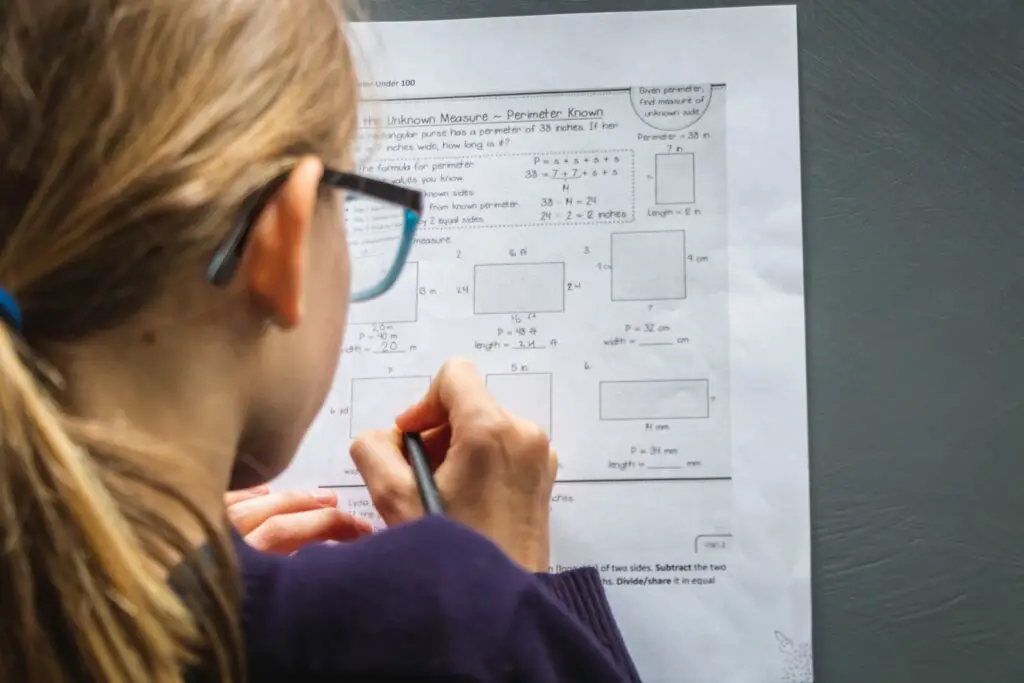
Email Templates – Emailing a Teacher About Homework
Template 1: seeking clarification on homework.
Subject: Clarification Needed for [Assignment Name] Due [Date]
Dear Mr./Ms./Mrs. [Teacher’s Last Name],
I hope this email finds you well. I am [Your Name] from your [Class Name, Period/Session]. I am writing to seek clarification on the [specific aspect] of our current assignment, [Assignment Name], which is due on [Due Date].
I have reviewed the instructions, but I am still unclear about [specific part you are struggling with]. Could you please provide some additional guidance or examples?
Thank you for your time and assistance. I look forward to your response.
[Your Full Name] [Your Class and Section]
Template 2: Requesting Extension Due to Illness
Subject: Extension Request for [Assignment Name] Due to Illness
My name is [Your Name], from your [Class Name, Period/Session]. I am writing to inform you that I have been unwell for the past few days and have been unable to complete the [Assignment Name] that is due on [Due Date].
I have made considerable progress on the assignment, but due to my illness, I am unable to complete it by the deadline. I respectfully request an extension until [Proposed Extended Date] to submit my work.
Thank you for considering my request. I apologize for any inconvenience this may cause and appreciate your understanding in this matter.
Best regards,
Template 3: Asking for Help with Difficult Homework
Subject: Assistance Needed with [Assignment Name]
Hello Mr./Ms./Mrs. [Teacher’s Last Name],
I am [Your Name] from your [Class Name, Period/Session]. I am reaching out because I am having difficulties with [specific aspect] of our homework assignment, [Assignment Name].
Despite reviewing the class notes and textbook, I am still struggling to understand [specific problem or topic]. I would appreciate any additional resources or guidance you could provide.
Could we possibly arrange a time to discuss this further, maybe during your office hours or a free period?
Thank you very much for your help.
Yours sincerely,
Writing an email to a teacher about homework requires clarity, respect, and a willingness to seek solutions. By approaching your teacher with a well-structured email, you can effectively communicate your needs and foster a positive learning environment.


No products in the cart.
- How to write an email to your teacher (with examples)
- Attention/ADHD
- Posted on January 3, 2024
- By Christine
- In Articles , Attention/ADHD , College Readiness

Knowing how write an email to your teacher, professor, or a school administrator in a polite and concise way is a must-have skill. In the fast-paced realm of academics, the art of writing emails is an essential life skill that fosters self-advocacy and responsible communication. While it may seem daunting, fear not – the process is more straightforward than it appears. This article will delve into an easy-to-follow guide with examples that will empower students to navigate this crucial aspect of effective and respectful correspondence.
Step 1: Nail the Subject Line
The subject line acts as the headline, grabbing the recipient’s attention. It should be specific and urgent, making the purpose clear from the start.
Subject: Urgent Math Grade Inquiry
Subject: MacBeth Essay Extension
Subject: Accommodations for ADHD
Step 2: Include a Friendly Greeting
Starting with a friendly greeting sets a positive tone. Using the teacher or professor’s name shows respect and personalizes the email, creating a connection. Make sure you’ve spell-checked the name.
- Hello Mr. Johnson ,
Dear Professor Meyers,
To Whom it May Concern,
Step 3: Introduce the Issue
A brief introduction is like a warm-up. It prepares the reader for what’s coming and shows that you’re not jumping straight to the problem.
- I hope you’re doing well. I wanted to talk about my math test from last week.
- I hope this email finds you well. I’m emailing you regarding an extension for the MacBeth essay due next Friday.
- Good afternoon. I am inquiring to learn more about ADHD accommodations .
Step 4: Provide the Scoop / Go into Detail
Getting into the details is crucial. Keep it real and straightforward, stating the facts to ensure the teacher understands the issue.
- I understand that we were supposed to get our grades back by now, but mine hasn’t shown up. I’m a bit worried about it.
- I came down with the flu last week and was unable to go to the library to finish my research. I’m concerned that my paper doesn’t meet the criteria for the number of primary sources.
- I would like to know what types of accommodations are available for me and how I can start the process of implementing them.
Step 5: Make a polite request
Asking politely is key. Acknowledge the teacher’s busy schedule and add a personal touch, making the request relatable. At the same time, attempt to convey the urgency of the matter.
Could you please let me know when I can expect to see my test grade? It’s stressing me out a bit, especially with finals around the corner.
Would you please consider a 1 week extension for the essay so I can finish my research now that my symptoms have resolved? I can provide a doctor’s note if needed.
Would you kindly guide me through the next steps? Classes start next week so I would like to have everything sorted by Friday.
Step 6: Express Gratitude and Understanding
Expressing gratitude shows maturity. It acknowledges that the teacher has a lot on their plate and emphasizes that the student values their time.
Thanks a bunch for taking the time to help me out. I know you’re super busy, and I appreciate any info you can give.
Thank you for considering my request for a 1 week extension. I know you must be very busy and I appreciate your time.
Thank you in advance for your assistance. I know the beginning of the school year can be very busy and I really appreciate your help.
Step 7: Sign Off with Respect
Ending with a simple “thanks” and your name is like a friendly wave goodbye. It’s respectful and brings a proper close to the email.
Thanks again, Alex
- Thanks again and I hope to hear from you soon, Alex
- Thank you and I look forward to your response, Alex
By following these steps, you’re not just sending an email; you’re building good communication habits and skills of self-advocacy. This way, you can express yourself clearly and respectfully, making sure your voice is heard in any academic situation.
How to Write an Email to Your Teacher (Asking about your grade)
Hello Mr. Johnson,
I hope you’re doing well. I wanted to talk about my math test from last week. So, we were supposed to get our grades back by now, but mine hasn’t shown up. I’m a bit worried about it.
How to Write an Email to Your Professor (Requesting an extension)
I hope this email finds you well. I’m emailing you regarding an extension for the MacBeth essay due next Friday. I came down with the flu last week and was unable to go to the library to finish my research. I’m concerned that my paper doesn’t meet the criteria for the number of primary sources.
Thanks again and I hope to hear from you soon,
How to Write an Email to a School Administrator (Requesting information about ADHD Accommodations)
Good afternoon. I am inquiring to learn more about ADHD accommodations . I would like to know what types of accommodations are available for me and how I can start the process of implementing them.
Thank you and I look forward to your response,
Related Articles
How to Pay for College
Beyond High School (BHS)
Stay Connected with Email Newsletters
Looking for Academic Support and other Educational Services?
You can schedule a free initial consultation to learn more about our services. We will listen to your concerns, answer any questions, learn about the student’s needs, and help guide you through our new student intake process.
Share this:
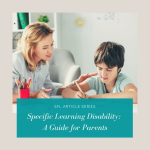
Specific Learning Disability: A Guide for Parents
What is dysgraphia and how to support it.
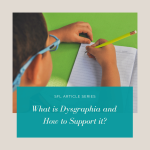
Recommended Posts

Benefits of a Good Summer Learning Plan

What is College Readiness?
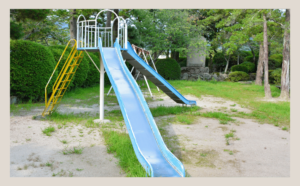
Maximizing Summer Learning

Positive Parent-Teacher Communication Strategies
You are using an outdated browser. Please upgrade your browser to improve your experience.

How to Write an Email to a Teacher: The Ultimate Guide [+ Expert Tips and Templates]
How to write an email to a teacher:.
- Ensure you have a good reason for emailing.
- Use their school email account.
- Choose the right time to email a teacher.
- Craft a detailed subject line.
- Greet a teacher respectively.
- Be concise and clear
- Format your email for better readability
- Be polite and show gratitude
- Label any attached files properly
- End an email with your full name, class, and institution

In the post-COVID world of distance learning and online classes, emailing teachers is a sign of good manners, a channel for submitting essays and other assignments , and a chance to resolve any educational issues officially.
This article is your ultimate guide on how to write an email to a teacher. Try to remember and follow the tips mentioned here, and you won’t have to blush for your writing mistakes and low manners anymore.
Table of Contents:
- Your reasons for emailing a teacher
- Best time to email a teacher
- Subject lines
- Email structure and format
- Your tone of voice
Attachments
- How to end an email to a teacher
- Practical tips on how to email a professor
- Don’ts of how to email a teacher
- How to write an email to a teacher: templates
When It’s OK and Not OK to Email a Teacher
Emailing teachers is a formal procedure, so you shouldn’t burden them with dozens of messages every time you have a common question about a paper’s due date or general information about the course. Before you decide to email a professor, check the following information sources:
- the course syllabus
- the FAQ section of your teacher’s online discussion board (if they have any)
- the assignment description
The big chances are that you’ll find answers to your question there and won’t need to email a teacher. Teachers deal with many students and get dozens of emails daily, so why bother them with issues you can solve yourself?
And yet, there are some good-enough reasons when an email is a must. What are they?
Your Reasons for Emailing a Teacher
Jessica Robinson, Educator and Content Creator for The Speaking Polymath , suggest a deciding factor that can help students understand whether they should send an email to a teacher or not:
“If a teacher gets involved with students for assignments and homework only, it’s best to write an email on nothing but work. But in the case of more personal relationships and a teacher’s openness, it’s OK to write emails related to emotional problems as well. Bullying or any other insecurities at school can be a reason to address a teacher and ask for help.”
Good-enough reasons for emailing teachers :
- Inform about your illness or any other emergency
- Say that you’ll be absent in class and why
- Ask for an appointment to see a teacher during the office hours
- Submit completed assignments
- Thank a teacher for a meeting, guidelines, or any other help
- Apologize for wrong behavior in class
When is it not OK to write an email to a teacher?
Zach VanderGraaff, Music Teacher managing DynamicMusicRoom.com , shares his insights:
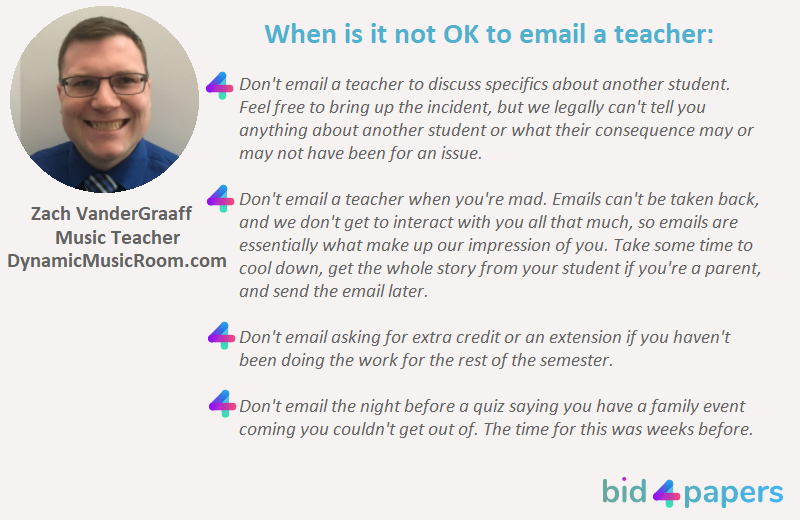
Rachel Coleman, Independent Education Consultant at CollegeEssayEditor.com , adds:
“Every teacher will set different standards for their relationship with their students. Some are more formal; others are more informal. The rule is to let the teacher define the boundaries and abide by them. If your teacher gives out her cell phone at the beginning of the year and says, “Text me if you need help on your assignments,” then you can assume texting is OK. If a teacher says, “Please only email me with the following questions: confusion about a homework assignment or grade, needing to miss class, requests for a letter of recommendation,” then it’s crucial to stay within the parameters of this instruction. But never assume! When in doubt, ask!”
Best Time to Email a Teacher
Zach also admits that emailing any time is OK, as long as you understand a teacher has boundaries too and can’t respond right away:
“ During the day, we have some time to send quick, short emails, but for the most part, we’re too busy teaching to respond with emails that require an in-depth answer. Want to increase the chances of getting a quicker turnaround? Then stick to the morning before school or toward the end of the afternoon. Most teachers do some emailing when they first get there and at the end of the day.”
Surveys confirm:
Teachers are more likely to open emails in the morning, between 7 am and 11 am , and then in the late afternoon, between 3 pm and 5 pm , when students have left school. So if you want to get a reply asap, organize your sending time accordingly.
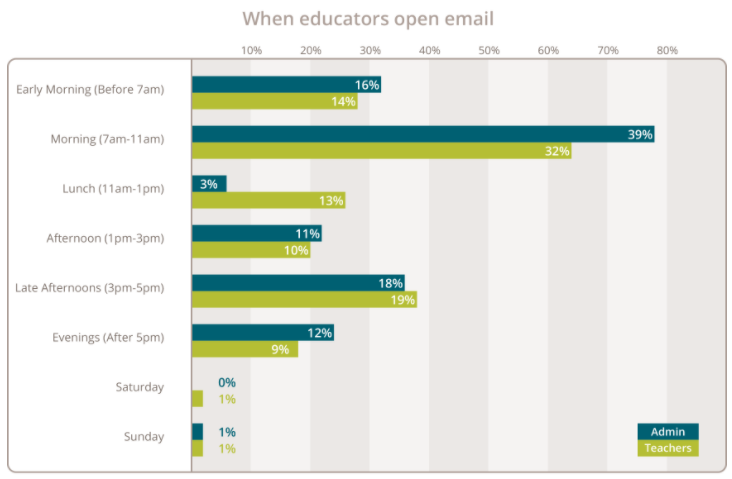
Source: Agile Education Marketing
Please avoid emailing teachers on weekends or holidays. Plus, it’s wrong to spam your teacher’s inbox when they don’t reply after hours.
Remember that teachers don’t spend all of their time at school. It’s best not to email them outside of their working hours. When you respect their personal life, they’ll be glad to help you as much as possible. For time-sensitive questions, don’t send emails less than 24 hours before you need a reply.
So, here’s a recap:
- Try not to email a teacher on weekends and holidays.
- Send your email during a teacher’s working hours.
- Don’t expect an immediate response: give them 1-3 days for a reply.
- Avoid spamming a teacher’s inbox every second hour; respect their time.
- Keep timing in mind when emailing on time-sensitive issues.
How to Start an Email to a Teacher
Two issues to consider here are your email’s subject line and the way you greet a teacher. It’s the first thing they see besides your name, so it’s critical to follow a few rules.
Subject Lines
The #1 rule: Make your email subject line as clear as possible.
Teachers have dozens of students and receive dozens of emails. The detailed subject line will help them understand who you are, what you want, and how time-urgent your message is.
No-no subject line examples:
- Homework question
- Assignment query
- Answer asap, please
- I’ll be absent tomorrow
Strong subject line examples:
- CHEM 112: Question about a lab on Monday
- Class meeting on Tuesday: 9:30 am
- Citation page for coursework: APA or MLA to use?
- Class 23: Confirming thesis for the assigned paper
They communicate the point to a teacher and help distinguish your email from colleagues, administrators, and other students. Plus, these subject lines are short and clear: They make a teacher understand the topic and urgency of your message.
Rebecca Rogers, School Teacher, author of this super cool TikTok account , confirms:
“I tell my students to make sure the subject line tells me what their email will be about because that will tell me how quickly I need to open that particular email. For example, if I have 20 emails to go through, I am more likely to open one with some urgency in the subject line first because I assume it needs my immediate attention. PLEASE DO NOT TYPE YOUR ENTIRE MESSAGE IN THE SUBJECT LINE! PLEASE! I AM BEGGING YOU.”
Her colleague Jessica Robinson, Educator and Content Creator for The Speaking Polymath , suggests students include their names in email subject lines:
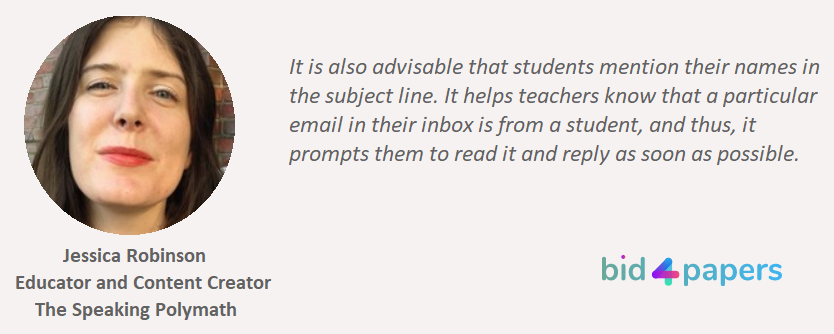
Other indicators such as the title of your class or the date of upcoming meeting can be helpful too. Consider examples like these:
- John Doe, class 42 – Question about research paper
- Tom Smith – Query regarding assignment on Geometry
- Biology 201: On the submission for Lab 3
- Lisa Martin: On upcoming meeting on Wednesday, 11 am
So, here goes a recap :
When emailing teachers, make your subject line short (less than ten words) and clear . Be as specific as possible: A teacher should understand at once who’s emailing and what’s the concern. Include your name and class to help a teacher identify you among dozens of other students.
The general rule here: Be polite and formal.
- Start with “Dear Dr./Mr./Mrs./Ms. Last Name” if you never met a teacher before or it’s the way you refer to them in class.
- Feel free to start with “Hello” or “Good morning/afternoon,” but make sure to personalize your greeting with names.
- Double-check the spelling of a teacher’s name. If in doubt, consider a school website, a faculty directory, or a syllabus to make sure you address a teacher correctly.
- Don’t be over casual, avoid greetings like “Hey” or “What’s up,” and try not to call a teacher by their first name unless it’s how you refer to them in lessons.
Rebecca nails it:

Long story short, consider your relationship with a teacher and the expectations of your institution. Refer to educators in the same way you refer to them in lessons. When emailing a teacher from different schools or colleges, please do your best to address them formally.
How to Write an Email Body
When emailing a teacher, some students forget about structuring the email body right. When sending a complete essay or any other assignment, it’s especially true: Students attach a file and click Send without adding any text to the email body.
It’s wrong!
Please always include a message in your email. Not only does it help a teacher understand the context of your message, but it’s also a sign of your good manners and respect.
Here’s how to write an email to a teacher, its body in particular.
Email Structure and Format
Remember that teachers are busy, so make the email body as short and straightforward as possible :
The ideal variant would be to keep it to five sentences or fewer. If that’s impossible, make sure to use short paragraphs and bullet points — therefore, your email will be quicker to scan. Yet, try to be concise and keep the email body fewer than 150 words. If you can’t express your message in 100-150 words, then maybe it would be better to email a teacher about a meeting in person.
Your email to a teacher is not a narrative or personal essay , so please avoid a flair of creativity. Stay concise and formal. Keep a single idea to one paragraph, and break them up for better readability. As Will Peach, medical school student and education blogger behind WillPeachMD.com , says:
“Don’t make your email an unsightly block of text (trust me, no teacher enjoys deciphering these).”
Speaking of formatting your email, please use standard fonts and text colors. Bold, italic, or underlined texts are OK if they help you convey a message or highlight crucial information (data, time, etc.), but say no to flashy fonts (those too large or too stylish) and rainbow text colors. Have mercy upon a teacher’s eyes!
That’s what Janice Wald, Teacher and Blogging Coach behind Mostly Blogging , recommends writing in email bodies:
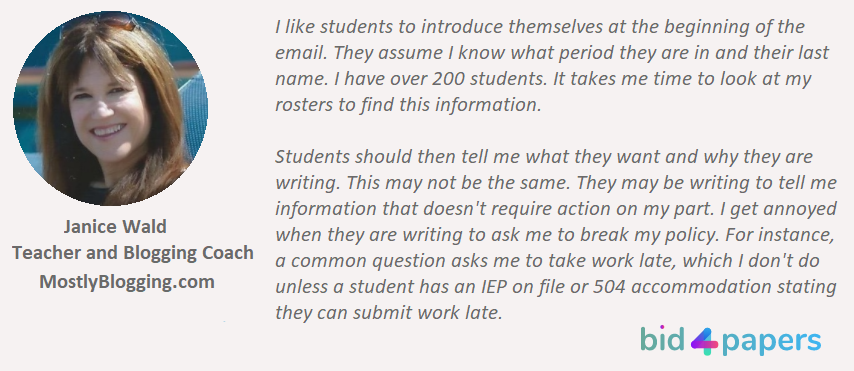
Here goes an example of how to email a teacher:
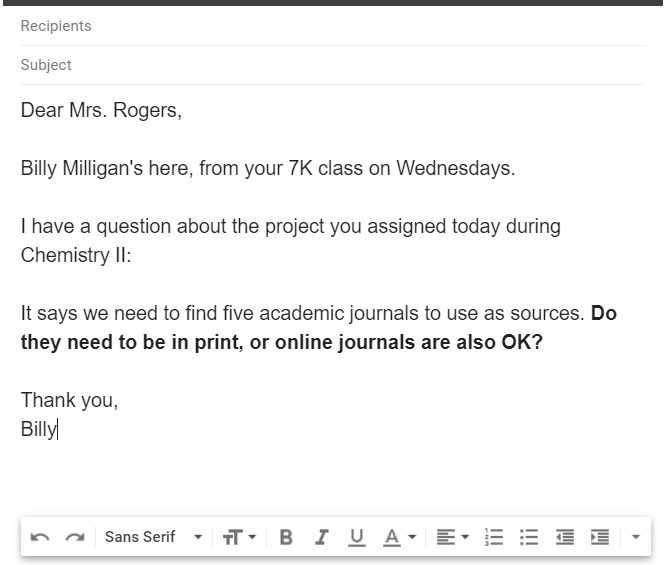
Your Tone of Voice
Being straightforward in emails doesn’t mean being sniveling or extra apologetic. When emailing a teacher, please keep your tone respectful .
- Avoid complaints about how much you dislike an assignment or how unfair a deadline is.
- No smileys or emojis — it’s OK to keep an email controversial, but it needs to be up-to-point.
- Avoid super long explanations, cliché statements like “I hope my email finds you well,” and saying how you’re sorry about disturbing a teacher. Be direct to the point.
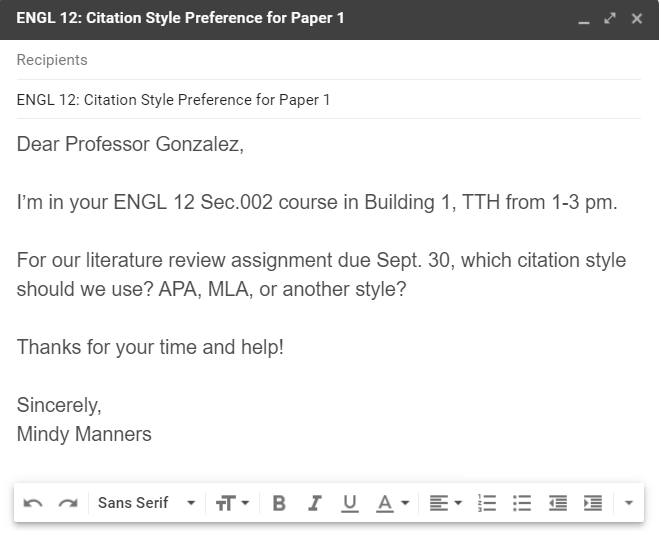
Here’s a practical tip:
Write a draft of your email in Microsoft Word or any other word processing software, not in the email program (Gmail, Outlook, or whatever you use). It will allow you to avoid grammar and spelling mistakes , as well as accidentally hitting Send before you’ve finished and proofread your email.
Emails to teachers often involve sending different attachments (complete assignments, tests, applications, etc.). If that’s your case, please follow a few rules:
- Do not attach files with no explanations. In the email body, provide specific details about what you send and why. (Example: “As you requested, I attach my critical essay here because I’ll be absent in class next Monday.” )
- Make sure to name your attached files appropriately. Include your name, class, the name of your assignment, and its number (or due date) if possible.
How to End an Email to a Teacher
Some students believe they don’t need to close an email because their names are evident in their email addresses. However, it’s a writing etiquette and your chance to add a personal touch to your formal email and show respect most teachers appreciate.
So, close your emails to teachers with courtesy.
First, sum your email up in one final sentence to spark a faster response. Consider variants like:
- Thanks in advance for your reply.
- I’ll look forward to your reply regarding my thesis statement .
- I will wait for your response before sending the complete test.
Second, remember to show gratitude and thank your teacher even before they respond. Phrases like “Thank you for your time” or “Thank you a lot for your help” positively influence how a teacher digests your information and regards you as a student.
And third, try to use formal closing lines. “All the best,” “Sincerely,” “Best regards,” or “Best” followed by your full name are great options to consider. Please avoid closings like “Cheers,” “Thanks,” or “See you tomorrow:” They are too casual for these reasons.
Schoolteacher Rebecca Rogers suggests:

Practical Tips on How to Email a Professor
Now that you know how to write an email to a teacher, here goes a quick recap:

You can also try to improve your email and teachers’ expectations even more with the following practical tips:
- Email a teacher only if you can’t find the necessary information in your class syllabus, school website, etc. Check all the options first; maybe you don’t need to write that email at all.
- Use a teacher’s school email address. It’s more professional, allowing them to keep all the correspondence with students in one place.
- Keep your email short and up-to-point.
- Remember about a proper greeting and closing.
- Draft your emails in a word document to avoid accidental sending. When finished and ready, copy-paste your message to the email program.
- Proofread and edit your email if necessary. Make sure to avoid spelling, grammar, and punctuation mistakes.
- Check the tone of your email. Stay formal.
- For complicated questions you can’t format into a 100-word email, it’s better to ask a teacher for an in-person meeting during their office hours.
Eric Kim, Co-Founder at LA Tutors , sums it up:
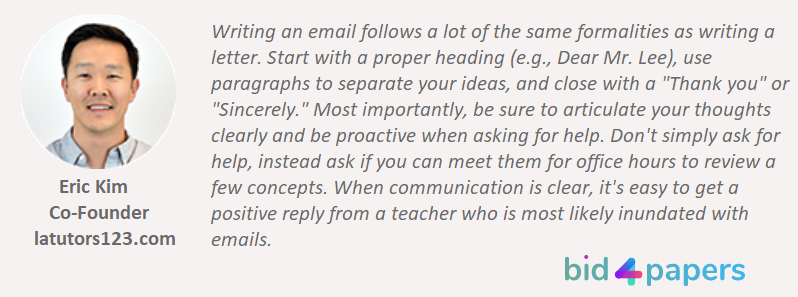
Don’ts of How to Email a Teacher
- Don’t email with questions you can ask in a class tomorrow. Respect a teacher’s time and privacy.
- Avoid colloquial or disrespecting language, common jokes, and personal topics.
- Don’t email a teacher with super time-sensitive questions. It may take them 1-3 days to reply, so keep timing in mind.
- Avoid slang, jargon, abbreviations, and emojis.
- Try to avoid contradictions in your email.
- Don’t write emails in CAPS.
- Say no to stylish fonts, super large or small font size, and bright text colors.
Faisal Nasim, Director of Exam Papers Plus , adds:
“The ONLY time you should email your teacher is if they have given you a school email account. If you’ve found a personal email address for them by some other means, do NOT email that account.”
- Don’t email to complain about other students or ask for extra credit.
- Avoid writing when you are sad or mad, and don’t use multiple exclamation marks.
- Don’t use textual language in emails.
- Never email teachers for purposes other than school-related. Avoid personal topics.
How to Write an Email to a Teacher: Templates
Below are a few templates (samples) you can use for writing emails to teachers. But before sending, make sure to customize and personalize them accordingly.
When asking a question:

When asking for a recommendation:
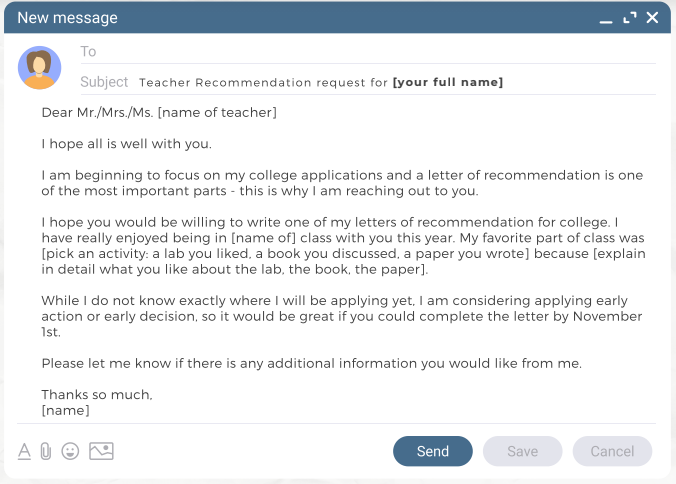
P.S. This template comes from Kate Sonnenberg, Tutor at KS College Success . Thanks for sharing, Kate!
If you need to ask for an appointment:

When you need to inform about your absence in class :

Following up with a teacher who hasn’t respond to your email yet:

Any questions or concerns left on how to write an email to a teacher? Feel free to ask our team for professional writing or editing help !
Related posts
- How to Write a Problem Statement for a Research Paper
- Tips on Term Paper Writing
- Footnotes: A Step-by-Step Guide with Word Instructions
Our Writing Guides
- About Katie
- Application Essays
- The Journal
- Join Thousands on My List

How to write an email to your teacher: Tips, rules and examples
Katie Azevedo November 7, 2019 good habits , grades , homework , self advocacy

By Katie Azevedo, M.Ed.
In most situations requiring you to communicate with your teacher, it is best to talk in person. I advise face-to-face meetings when possible because this reduces the chance of miscommunication. In-person meetings also give us the chance to communicate via body language, which is important if you struggle with verbal expression.
However, there are times when face-to-face meetings aren’t possible and you have to write an email instead. For these reasons, you need to know how to write an email to your teacher so that your message is clear and respectful, and also so that you get a response that addresses your concerns.
If your email is unclear and your questions are indirect, you won’t likely get the clear and direct answers you’re seeking — makes sense, right?
Knowing how to write an email to your teacher isn’t just a school-skill; eventually you’ll be writing emails to your boss, to your co-workers, and to other high-rollers. And because you can’t hit “unsend,” you better get it right the first time. If you’re out of school and in the workforce, these email tips, rules and examples apply to you as well.
Okay, onto the rules, the dos and the don’ts.
How to write an email to your teacher (or to your boss, colleague, principal, etc.)
1. Repeat after me: an email is not a text message!!!
2. Repeat after me: an email is not a novel or an epic poem.
3. Always enter in a subject line. Never leave this field blank. Keep it short and to the point, basically like giving your email a “title.” Don’t be creative, don’t use capital letters (no need to SHOUT), and avoid exclamation points unless it’s an actual emergency … in which case….call 911?
Examples of good subject lines:
- Retaking Monday’s test
- Staying after school this week
- Question about tonight’s homework
- Scheduling a time to meet
Examples of terrible subject lines:
- [no subject]
- WHAT DID I MISS???
- i lost my homework and i dont know where to get another copy can you send me another one
4. Use a proper greeting. In fancy language, this is called a salutation. I’m not fancy. In most scenarios, when writing an email to your teacher, you will use “Dear Ms. Smith” – or whatever your teacher’s name is. If you have had your teacher for more than a few weeks, it is okay to use “Hi Ms. Smith.” In either case, always close your salutation with a comma.
Examples of good email greetings:
- Dear Mr. Smith,
- Hi Mrs. Jones,
Examples of bad email greetings:
- What’s up.
5. Introduce yourself. Unless you’re in elementary school and you only have one teacher, the first sentence of your email should clearly and directly state who you are. Don’t skip this step even if your email address contains your name. Keep this information basic and relevant (your teacher/boss doesn’t need to know your shoe size). Do not write more than one sentence.
Examples of good introductory sentences:
- This is Maria Ricci – I am in your A-period chemistry class.
- This is Chrissy Holmes, and I am in your Tuesday night Economics 101 lecture.
6. Write a brief overview sentence. This is an important , simple, single sentence that clearly states why you are writing the email. It should be similar to your subject line. If this sentence doesn’t match your subject line, go back and edit your subject line.
Examples of good overview sentences:
- I’m writing to you because I was absent on Tuesday and I have some questions about what I missed.
- I’m emailing you to follow up about our conversation we had after class yesterday.
- I’m writing to you because I’m looking for some extra help with the material we covered this week.
7. Write the email body. This is where you state your message and/or ask your questions, and is the whole reason you are writing. Be direct, be clear, and be brief. Ideally, this section should be five sentences or less. If you have multiple questions, use bullet points. If your sentences are long, then use extra line breaks (paragraphs) to separate the text into smaller chunks. (See the extra tips below for more about paragraph size and readability.)
8. Thank your teacher/boss and close out the email. Again, keep this part of your email brief.
Examples of good email closures:
Thank you! Sincerely, Meggan Meggles
I appreciate your help. Billy Bob
9. Proof before sending. Don’t skip this step! Read the email aloud to yourself to catch any funky parts, and review the email for spelling errors or word-choice errors. For the love of everything holy, capitalize your “I”s.

Now that you know how to write an email to your teacher (or boss), consider the following tips as well.
1. Keep paragraphs to no more than four-ish sentences each.
2. Limit exclamation points. If you simply MUST use one, limit yourself to one exclamation point per email.
3. Avoid blame and take responsibility. If you’re emailing your teacher about an issue you have with your grade or about a problem you’re having, be careful with your wording. Instead of “I don’t get why you gave me an F!” you could write “I got an F on the assignment, and I’m hoping you could help me understand what I did wrong.” Taking ownership is a much better approach and will increase the chances of your teacher helping you.
4. For high-stakes emails – like if you’re emailing your principal or boss – send the email to yourself first. Doing so gives you one last chance to proof it for dumb mistakes and/or errors in tone.
5. Keep it short. Any email longer than 10-12 sentences is better off as a phone call or an in-person meeting
6. Don’t overdo formatting. Avoid colors, weird fonts, all-capital letters, and excessive bold and italics. An appropriate place to use bold might be to highlight dates and times, like in the following example:
Would you be able to meet with me on Tuesday, November 20th at 2:00 ?
7. Avoid jokes and sarcasm. Save the humor and sarcasm for in-person conversations, as it’s easy for the recipient to misinterpret your tone without hearing your voice or seeing your body language / facial expressions.
Emailing is an effective and efficient form of communication when done correctly. So keep it simple, keep it respectful, and PROOFREAD!
Here are the 4 pillars of email management for students . If you’re overwhelmed in your inbox, follow these 4 steps.
If you struggle with asking for help, here are some key tips for you .
Subscribe to ReportCard Newsletter!
Get your FREE download of 25 School Habits and Hacks when you sign up for our monthly newsletter featuring awesome school tricks and tips
I will never give away, trade or sell your email address. You can unsubscribe at any time.
How to Write an Email to a Teacher (11 FAQs Answered)
When it comes to interacting with academic staff, you can go for a quick face-to-face conversation in most cases. However, if you need your teacher’s help outside of their office hours, it’s best to send them a formal email.
Students usually email their educators for assignment clarification, deadline extension, or help with a specific project. There are plenty of formal email templates online, and we’ll list some of them in this article too.
If you’re trying to figure out how to write an email to a teacher and need to do it for the first time, you’re likely to be confused or anxious about receiving a response. We’re here to help with step-by-step instructions. Keep reading to learn how you should address your teacher, the proper way to write and reply to a formal email, and more teacher emailing tips.
Sending a Mail to a Teacher — Dos and Don’ts
1. how to write a formal email to a teacher.
(Grammar.yourdictionary.com)
Both students and parents may need to correspond with educators occasionally. The formality level applies whether you need to write an absence email to your child’s school, ask about class performance, or have assignment questions as a student. Keep in mind that some tutors may be more easy-going and allow or encourage less formality in the communication.
The general emailing guidelines include using a clear subject line, starting with a correct greeting, ending with a formal salutation, and being respectful throughout. These are just some of the basic instructions on how to write an email to a teacher. Make sure to structure your email as a formal letter and keep it short.
Open up a Word document and type the email there to ensure you don’t accidentally send it before it’s finished. Remember to proofread it. Once you’ve completed the email, send it from your school email address to the email your teacher has given you.
2. How to address a teacher in an email?
(Insidehighered.com)
Now that you are familiar with the basics of writing a formal email, it’s time to move on to specifics.
Your teacher should know what the email is about at first glance. They may receive numerous emails from students, so being straight to the point saves time and makes communication easier. This is why your subject line is important. Moreover, there are certain salutations for teachers that you should use to start an email. For example, you can greet a teacher with a “Hello” or a “Good afternoon.” Remember to add their title and last name.
Avoid writing the email the same way you would text your friends, as it’s not appropriate, even if you’re friendly with your teacher during the class. There’s no need to use abbreviations, and make sure to use correct punctuation, spelling, and grammar.
3. How to start an email to a teacher?
(STEM diversity network)
“Hello” and “Good afternoon” are just examples of formal greetings. “Good morning” or “Dear” followed by your educator’s title and last name are also acceptable. Tip: words like “hey” or “hi” would be too informal.
After an appropriate salutation, you should introduce yourself with your name and class or course. Be mindful of their time and clearly state what they can help you with. If needed, suggest meeting in person for further discussion.
4. How to end an email to a teacher?
(Howtodiscuss.com)
Conclude the email by thanking your teacher for their time, assistance, or advice. Put a formal signature at the very end of your email. A good example of what you can end your email with is “Sincerely,” “Best wishes,” or “Thank you,” followed by your full name.
Once you’ve completed the email, reread it to check its contents, and proofread it. You’re then ready to send it.
5. How to write an email to a professor?
(Academic Positions)
If you’ve already sent emails to your teacher in the past, you’ll notice writing an email to a professor isn’t all that different. Start it off with a proper salutation and be straightforward, but provide enough context so they can remember you and respond to your question faster. Avoid explaining what happened in your personal life and focus on the issue. Sign off appropriately and use your university email address to send it.
6. How to write an email to a teacher asking for something?
(Moviecultists.com)
You may need to email your teacher to ask for notes, help with your assignment, or solve other potential issues with your schoolwork or homework. Asking for something comes down to being polite and concise with your request. If you need to email multiple educators, open up with “Dear professors” or “Greetings.” Make sure to use a proper email format like the one we’ve dissected in the previous sections and end with a formal closing.
7. How to write an email to a teacher about grades?
(World Scholarship Forum)
If you’re struggling in a class, it’s okay to ask your educator to help you get better grades. You can come back to this article at various levels of your education, be it school or college. You don’t need a specific email format to ask about grades. However, you can find a sample email to send to your professor regarding your grade online. Always follow the general emailing guidelines listed here, whether you’re sending an email to a teacher or professor.
The point of emailing your tutor about grades is to find out why you received a poor grade and how to improve it. You can explain that you want to excel or express concern about a grade on a particular paper you wrote. You may ask for a chance to improve your grade through an additional assignment. Remember to add your class details when sending an email to your teacher about your grades.
Students usually ask for an assignment replacement, a chance to get one more grade, or take a grade out of a particular assignment. If you’re concerned about a grade, feel free to ask for clarification, either via email or in person. Keep a respectful tone, avoid blame-shifting, and show that you’re willing to do what it takes to improve.
8. How to email a teacher for a letter of recommendation?
(Cleverism.com)
Whether you’re applying for a graduate program, an internship, or a job, you may need to ask your educator for a letter of recommendation at some point. It’s highly suggested to do this in person, but emailing a professor that knows you well is also a good starting point. Along with your resume and cover letter, a letter of recommendation will set you apart from other candidates and thus increase your chances of getting accepted.
Knowing how to write an email to a teacher is essential, whether you’re asking for grade improvement or a letter of recommendation. Being patient with a reply after you’ve sent it is important, as your educator is busy and will need to take their time writing a quality letter for you. Aim to send a letter of recommendation request at least a month before you’ll actually need it.
9. How to write an email to an old teacher?
(The Life Virtue)
If your past teacher has impacted your life in a meaningful way, you may want to thank them for everything they’ve done for you. You already know the basics of corresponding with academic staff. While maintaining a respectful tone is still necessary, writing to your old teacher is also an opportunity to express a more personal side of things in a positive manner.
A thank you email to your teacher should be proper, since it allows you to expand on what you’re thanking them for. It doesn’t have to be short and straightforward. You can write about how your tutor has inspired you, directed you, or changed you for the better. You can thank them for being a good role model or helping you discover your hidden talents.
When emailing a former teacher to say thank you, you can incorporate any thoughts of appreciation. Feel free to make it a heartfelt thank you letter. In addition to what we’ve already mentioned, they may have helped you polish a skill or pushed you to be the best you could be. If they understood and encouraged you to face a problem during your education, you can include that as well.
10. How to respond to a teacher email?
(Eliteprep.com)
Whether you’re communicating with a teacher or a college professor, you should reply once you receive their response. Remember to start with a salutation and end with an appropriate signature, just like you did in your initial email. Use correct spacing to avoid creating a hard-to-read block of text. Replying to the response ensures you’re formally thanking the tutor for taking the time to respond and give you the information you need.
11. When is it not ok to write an email to a teacher?
(Bid4papers.com)
We’ve covered a list of good reasons to send an email to your teacher. You’ve learned that you shouldn’t burden an educator with personal problems and excuses. You can send an email about a specific question anytime, but teachers generally respond in the early morning or after students leave school.
As long as you aren’t rude and know the proper way to email a teacher, you can ask about almost anything you need help with. However, discussing other students and making excuses for not doing a test are highly inappropriate. This also applies to asking for deadline extensions or extra credits when you haven’t been doing your schoolwork.
Knowing how to write an email to a teacher is a skill you’ll need throughout your education, so it’s best to learn early on. Most emails sent to educators are centered around specific questions. However, some email types may give you more leeway to interact with academic staff more informally. Thanking an old teacher or professor is an opportunity to express your gratitude for their positive influence on you during your studies. Being less formal with your current teacher is acceptable if they give you the green light to do so.
Grammar.yourdictionary.com Insidehighered.com STEM diversity network Howtodiscuss.com Academic Positions Moviecultists.com World Scholarship Forum Cleverism.com The Life Virtue Eliteprep.com Bid4papers.com
How To Write A Clear, Polite Email To A Teacher — With Examples
Yes, even when you’re big mad.

Why is it that approaching our kids' teachers can spike our anxiety? Maybe it's past trauma from our grade school years. Perhaps it's the fact that emotions run high when it comes to our kids, so we know a tense conversation could be the outcome . Whatever the reason, it's something that we parents will definitely have to overcome since, at some point in each child's K-12 years , the need to communicate with their teachers will inevitably come up. Fortunately, it will probably be as easy as shooting over an email (especially in this digital age). But that prospect isn't without worries, either. You might even be wondering how to write an email to a teacher in a way that is appropriate, respectful, and conveys the point you're trying to make.
Depending on the matter you're reaching out to discuss, it could either be a breeze or perhaps a little awkward. But isn't that a big chunk of parenthood — facing awkward situations caused by the little people in our lives? With the right approach, this doesn't have to be one of them. So, if you're curious about the proper protocol, stick around for a few examples.
Subject Line
Teachers get a slew of emails, so keeping it short but informative will help them differentiate between an important email and one that can wait. It can also help them identify which one of their students it concerns and what it pertains to.
Instead of:
" Homework question… "
" Question about Gabe's math homework due this week "
If you've never met your child's teacher before (which might be the case for many parents these days), play it safe and stick with something polite and formal. A good rule of thumb is to address teachers the same way your child would.
"Hey, Sarah!"
"Good morning, Ms. Brown!" (And use "Ms." if you're unsure of their marital status.)
Email Body and Format
Teachers are busy! Remember, they have an average of 24 students. Keeping your email clear and concise is just one way to show your respect for their time. If the matter requires a lengthier conversation, don't jump right into the meatier stuff in your initial email. Instead, give the teacher a clear understanding of what you need to discuss, ask them for their availability, and, if possible, express your flexibility in setting up a chat.
"Gabe is having problems with some of his classmates that, from what I understand, are due to an incident on the playground a few weeks ago. He says Megan excluded him from a basketball game, which made him really sad..."
"I'm concerned about Gabe's relationship with his fellow classmates, and I'd like to set up a brief chat with you so we can resolve the issue. Please let me know your availability for next week. I'm flexible."
Tone of Voice
Teaching isn't an easy job, and most teachers do it because they truly care about the education of children — including yours. Using a respectful tone when emailing your child's teacher is not just an option; it's simply the right thing to do. If a teacher has done or said something that you feel is inappropriate, remain respectful and take up the matter with the principal or other school official, if necessary.
"I don't appreciate that you've been sending home so much homework. It's really a lot to deal with, and it's overwhelming for my child!"
"Keeping up with the homework assignments has been a bit of a challenge for our family. Is it possible to make some adjustments?"
Attachments
Sometimes you may need to add an attachment to your email, like if your child is out sick and you need to submit their makeup classwork. Make sure your email mentions any attachments, and name each attachment appropriately. Also, remember that most email servers allow a maximum of 25 MB per attachment. Sending a link to a cloud drive is a great alternative to attachments.
Like the greeting, ending your email with a polite sign-off shows your respect and may even increase your chances of a quicker reply.
"Talk to you soon! – Gabe's mom"
"Thank you in advance for your time and reply! Sincerely, Melissa Smith (Gabe's mom)"
The next time you need to reach out to your child's teacher, you'll know exactly how to start and write an email that follows protocol and doesn't leave your index finger hovering over the send button in doubt.
Additional Tips for Emailing Teachers
Gone are the days of sending your kid to school with a note. Well, not completely, but email is instantaneous and way more efficient than using children as messengers. But these email interactions can sometimes be a little tricky and stressful. So, here are a few tips you can use when communicating with your child's teacher via email.
- Use your professional email address if you have one. Messages are more likely to get lost in your personal one.
- Before you add a link or attachment, ask yourself if it’s vital to the message. You don't want to clog the email with information the teacher may not need.
- In the email, push for a phone call or a face-to-face meeting. With kids, few issues can be resolved via email. It's best to get in front of the teacher if you can.
- As parents, we go to bat for our cubs no matter what, and you can still do that without hurting the relationship you have with your child's teacher. If you're especially teed off or emotional, take a beat and come back to writing the email a little later. You'll write a much clearer and concise email if you give yourself a little time.
*Keep in mind teachers don't blame parents for their child's actions. An educator's job includes juggling 10 to 20 children, each with their own personality and needs. It's important to remember to give teachers the benefit of the doubt. Teachers are part of the community used to raise a child, so try to see them first as team members instead of adversaries.
This article was originally published on March 18, 2022

Grammar check | Essay checker | Writing checker
February 15, 2019
What should I write in an email to my teacher?
by Nicholas Walker , under Writing skills

Students aren’t often aware of the impact of their emails on their teachers. Well-written emails strengthen the relationship. Poorly-written emails will arouse resistance and opposition. You don’t want that.
Teachers are committed to helping students succeed and prosper. Really.
It only makes sense for students to learn to write emails that maximize their chances of getting the help and support they want and need from the people who want to help and support them.
Here are a few things to keep in mind the next time you send an email to your teacher.
- Write your email in English. English teachers like that.
- Write an information-rich subject line: Online quiz problem in Lesson 4
- Begin with a salutation followed by a comma: Dear Professor Walker,
- Show some concern for the person reading the email: I hope you are having a good day.
- Remind your teacher how he knows you: I’m in your Monday 8-11 class.
- Say why you are writing your email: I am writing this email to tell you about a problem I am having and to ask you for your help.
- Be specific and get to the point: For some reason, I wasn’t able to do the online reading quiz on Labodanglais.com in Lesson 4. The quiz closed without warning, and it gave me a score of zero.
- Politely say what you want: Could you reset the quiz for me when you get the chance?
- Show some gratitude: I would really appreciate it.
- Say when you will contact the teacher again: See you in class on Monday.
- Close with a standard greeting: Best wishes,
- Add your name: Justin Trudeau
- Check your email for errors using the Virtual Writing Tutor grammar checker .
SUBJECT: Online quiz problem in Lesson 4 Dear Professor Walker, I hope you are having a good day. I’m in your Monday 8-11 class. I am writing this email to tell you about a problem I am having and to ask you for your help. For some reason, I wasn’t able to do the online reading quiz on Labodanglais.com in Lesson 4. The quiz closed without warning, and it gave me a score of zero. Could you reset the quiz for me when you get the chance? I would really appreciate it. See you in class on Monday. Best wishes, Justin Trudeau
Don’ts
- Don’t forget any of the steps listed above.
- Don’t repeat any of the steps listed above in any subsequent exchanges. It usually isn’t necessary since the email thread will contain all of the previous pleasantries.
Big mistakes students make
Some students write their emails angry and confused.
You can imagine a student suddenly feeling very needy and a little annoyed while doing his or her homework. Something went wrong. Because of the pressure that student feels, he or she decides to get help from the teacher with a particular problem. However, instead of thinking how to get the teacher to sympathize and then assist with the problem, the student decides to share his or her annoyance and complain.
The website bugged on me and gave me zero on a quiz. I am not happy.
Many teachers will simply choose to ignore an impolite student’s email. Other teachers will engage. I tend to engage. I figure that I have a job to do. The student obviously doesn’t know how to communicate effectively in English, I have made a commitment to assist students outside of the classroom with office hours and emails, so it is my job to help students communicate. I might ask a few pointed questions.
Who are you? Why are you being so rude? Which website? Which quiz? Which course? Which group? What do you want? Best wishes, Nicholas Walker
I realize that the tone of such a reply is rather hostile, but I’m no pushover. The student wanted a frank exchange. Wish granted.
The real issue is this. Whether your teacher responds or not, the opportunity to build and strengthen the relationship between the teacher and the student will have been lost. Now, the relationship is infused with annoyance and frustration on both sides.
The big solution
If you are a student, learn how to write a proper email. You will get better results.
If you are a teacher, take a minute to communicate your expectations. If this blog post helps, please feel free to share it.

Want more like this?
Get new posts by email, recent posts.
- ConverSolo to Provide AI Language Learning Tools to Quebec Colleges and University– A First of its Kind AI Application in Higher Learning
- Virtual Writing Tutor Membership Plan Options
- Automated Essay Scoring Moodle Plugin
- 30 conversation questions to ask a traveler or a voice-enabled chatbot
- Inflation for ESL students
- Improve Writing
- What’s my English level?
- Automatically Scored Emails
- ESL Strategies: Flashcards
- Applied Linguistics at Concordia University
Enjoy this blog? Please spread the word :)
How To Write Email To Teacher

- How-To Guides
- Tech Setup & Troubleshooting

Introduction
Welcome back to school! As you settle into your new academic year, it’s only natural that you will have questions, concerns, or even the occasional need for clarification. Fortunately, email provides a convenient and efficient way to communicate with your teachers. However, crafting an email to a teacher requires a different approach than writing to a friend or family member. In this article, we will explore some essential tips on how to write an email to your teacher effectively.
Whether you’re seeking guidance on an assignment, requesting a meeting, or addressing any other academic matter, it’s crucial to express yourself clearly and professionally. By adhering to a few basic guidelines, you can ensure that your message is respectful, concise, and easy to understand.
In the following sections, we will discuss specific strategies to help you construct an email that will make a positive impression on your teacher. We will cover important aspects such as the proper greeting, subject line, tone, content, and proofreading. By mastering these skills, you will not only demonstrate professionalism but also increase the chances of receiving a prompt and helpful response.
So, whether it’s a simple question or a complex problem, let’s dive into the art of writing an effective email to your teacher. By the end of this article, you’ll have the tools you need to confidently communicate with your instructors, forging a strong and productive academic relationship.
Start with a Polite Greeting
When composing an email to your teacher, it’s important to begin with a polite greeting. This sets a respectful and friendly tone from the outset and shows your teacher that you value their time and expertise. Addressing your teacher using the appropriate title, such as “Dear Professor Smith” or “Hello Mr. Johnson,” demonstrates your understanding of proper etiquette.
Keep in mind that the formality of your greeting may vary depending on the teacher’s preferences and the nature of your relationship. It’s always best to err on the side of formality unless instructed otherwise.
In cases where you are less familiar with the teacher, or if you are addressing multiple teachers in the same email, a generic salutation such as “Dear Faculty” or “Dear Teachers” can be appropriate. However, it’s always ideal to address the recipient by name whenever possible.
Remember to use a polite and respectful tone throughout your email. Avoid using overly casual language, slang, or abbreviations that may come across as disrespectful or unprofessional.
Here’s an example of an appropriate greeting:
Dear Professor Johnson,
Starting your email with a polite greeting not only establishes a positive tone but also shows your teacher that you value their time and expertise.
Use a Clear and Descriptive Subject Line
When writing an email to your teacher, a clear and descriptive subject line is essential. The subject line should succinctly summarize the purpose or main topic of your email. This allows your teacher to quickly identify the content and prioritize their responses accordingly.
Avoid vague or generic subject lines like “Question” or “Help Needed.” Instead, provide specific information that accurately reflects the nature of your email. For example, if you are seeking clarification on a homework assignment, a subject line such as “Question about Homework Assignment Due on [Date]” would be more informative and helpful.
Using a clear subject line also allows your teacher to search for and reference your email in the future, making it easier to locate important information or follow up on previous discussions.
Here are some tips for crafting an effective subject line:
- Be specific: Clearly state the main topic or purpose of your email.
- Keep it concise: A subject line should ideally be no more than a few words or a short sentence.
- Avoid using unnecessary words or symbols: Only include relevant information to keep the subject line clean and easy to read.
- Use keywords: Include important keywords related to the subject matter to make it easier for your teacher to categorize and search for your email.
Remember, an informative subject line not only helps your teacher understand the content of your email at a glance but also increases the likelihood of a prompt and precise response.
For example, let’s say you are requesting a meeting with your teacher to discuss an upcoming exam. A concise and descriptive subject line could be:
Request for Meeting to Discuss Exam Preparation
By using a clear and descriptive subject line, you ensure that your teacher understands the purpose of your email right away, leading to more effective communication.
Address the Teacher Appropriately
When writing an email to your teacher, it’s important to address them appropriately. How you address your teacher sets the tone for your communication and shows respect for their role as an educator.
Start by using the correct title and surname. If you are unsure about how to address your teacher, it’s best to use a formal title such as “Professor,” “Doctor,” or “Mr./Ms./Mrs.” followed by their last name. For example, “Dear Professor Johnson” or “Hello Dr. Smith.”
However, if your teacher has explicitly stated their preference for a different form of address, such as first name or a specific title, it’s important to use that instead. Pay attention to any instructions provided by your teacher or refer to how they introduce themselves in class or on course materials.
Remember to double-check the spelling of your teacher’s name and ensure that you are using the correct form of address. Using the wrong name or title can be perceived as disrespectful or inattentive.
In some cases, you may have a more informal or friendly relationship with your teacher. If this is the case and they have given you permission to use their first name, you can address them by their first name in your email. However, be cautious and considerate when deciding to adopt a more informal tone. Maintain a level of respect and professionalism throughout your communication.
Here’s an example of how to address your teacher appropriately:
Addressing your teacher with the appropriate title and surname shows respect and professionalism. It’s important to follow their preferred form of address or use a formal title and last name if no specific preference is given.
State the Purpose of Your Email
When writing an email to your teacher, it’s crucial to clearly state the purpose of your communication. Clearly articulating why you are reaching out helps your teacher understand the context and importance of your email and facilitates a more targeted response.
In the opening paragraph of your email, briefly mention the main reason for contacting your teacher. This could be a specific question, a request for clarification, a need for additional resources, or any other academic matter you would like to address. Be concise and specific in your wording to ensure that your teacher understands the purpose of your email.
Avoid burying your main point in lengthy paragraphs or unrelated content. Instead, prioritize clarity and brevity to convey your intentions effectively.
If you have multiple topics to discuss, consider using bullet points or numbering to organize your thoughts. This helps your teacher understand the different points you want to address and ensures that nothing gets overlooked.
Here’s an example of how to state the purpose of your email:
I hope this email finds you well. I am writing to request clarification on the requirements for the upcoming research paper in your English literature class. Specifically, I would like to better understand the expectations for the length, sources, and formatting of the paper. Additionally, I would appreciate any guidance you can provide regarding the recommended research process and potential sources to explore.
By clearly stating the purpose of your email, you set the foundation for a focused and productive conversation with your teacher.
Be Concise and to the Point
When writing an email to your teacher, it’s important to be concise and get straight to the point. Teachers are often busy with various responsibilities, so keeping your email concise demonstrates respect for their time and allows them to easily understand and respond to your message.
Avoid rambling or including irrelevant details. Instead, focus on clearly expressing your main point or question in a few sentences or short paragraphs. Use clear and straightforward language to convey your message effectively.
To maintain clarity and conciseness:
- Stick to the topic: Stay focused on the purpose of your email and avoid going off on tangents.
- Use bullet points or numbered lists: If you have multiple points or questions to address, organize them in a concise and structured format.
- Avoid unnecessary repetition: Make sure each sentence and paragraph adds new information or contributes to your main point.
- Keep paragraphs short: Break down your thoughts into smaller paragraphs for easier reading and comprehension.
Being concise doesn’t mean sacrificing politeness or omitting necessary details. However, it’s crucial to find a balance between providing enough information and overwhelming your teacher with excessive text.
Here’s an example of how to be concise and to the point:
I hope this email finds you well. I wanted to follow up on our recent discussion in class about the upcoming group project. My group members and I would like to request an extension of two days for the project submission deadline due to unforeseen circumstances. We believe this additional time will allow us to deliver a more comprehensive and polished project. Thank you for considering our request, and we look forward to your guidance regarding the revised deadline.
By being concise and direct in your email, you respect your teacher’s time and increase the likelihood of receiving a prompt and efficient response.
Provide Necessary Information and Context
When writing an email to your teacher, providing necessary information and context is crucial for effective communication. By including relevant details and explaining the background or circumstances surrounding your inquiry, you help your teacher better understand your situation and provide an appropriate response.
Start by briefly outlining any relevant assignments, topics, or discussions that relate to your email. This helps your teacher connect your message to the appropriate context and ensures that they have the necessary information to address your concerns.
If you are seeking clarification on a specific assignment or class material, provide specific references, such as the assignment number or the date the topic was discussed. This allows your teacher to pinpoint the information you are referring to and provide accurate and targeted guidance.
Additionally, if you have attempted to find the answer to your question or resolve the issue independently, mention your efforts in your email. This shows your initiative and willingness to problem-solve, which your teacher will appreciate.
However, avoid overwhelming your teacher with excessive information or unnecessary background details. Stick to the relevant facts and keep your explanations concise.
Here’s an example of how to provide necessary information and context:
I hope you’re doing well. I’m writing to seek further clarification on the recent lecture about the laws of thermodynamics. During the lecture, you mentioned the concept of entropy and its relationship to energy transfer. I’ve reviewed my notes and textbook, but I’m still struggling to grasp the concept. Could you please provide some additional examples or resources that could help me better understand how entropy relates to energy transformations? I’ve also attempted to research online, but I haven’t found any explanations that resonate with me. Any guidance you can provide would be greatly appreciated.
By providing necessary information and context, you help your teacher understand the specific area in which you’re seeking assistance, increasing the chances of receiving a clear and helpful response.
Use Proper Grammar and Spelling
When writing an email to your teacher, it’s essential to use proper grammar and spelling. A well-written email demonstrates your professionalism and attention to detail, leaving a positive impression on your teacher. Clear and error-free communication also helps ensure that your message is easily understood.
Take the time to proofread your email before sending it. Check for any spelling or grammatical errors. Review your sentences for clarity, and make sure your thoughts are expressed in a coherent and organized manner. Consider using tools like grammar and spell-checkers to assist you in spotting any mistakes.
Be mindful of commonly confused words, such as their/there/they’re, your/you’re, or its/it’s. Using these words correctly contributes to the overall clarity and coherence of your email.
When in doubt about the proper usage of a word or phrase, consult a reliable reference source, such as a dictionary or grammar guide. You can also ask a trusted peer or teacher to review your email before sending it to ensure that your writing is clear and error-free.
If English is not your first language, it’s even more important to double-check your grammar and spelling. Taking the time to communicate effectively in English shows your dedication to improving your language skills and your respect for your teacher’s linguistic expectations.
Here’s an example of an email with proper grammar and spelling:
I hope you are well. I am writing to inform you that I will be unable to attend the afternoon lecture on Monday, October 18, as I have a doctor’s appointment scheduled during that time. I apologize for any inconvenience this may cause. Could you please let me know if there will be any important material covered during the lecture that I should review independently? I appreciate your understanding and assistance.
By using proper grammar and spelling, you ensure that your email is clear, professional, and easily understood by your teacher. Taking the time to proofread and edit your email before sending it demonstrates your attention to detail and commitment to effective communication.
Include Attachments or Relevant Documents
When writing an email to your teacher, it’s important to include any necessary attachments or relevant documents to support your inquiry or request. Including these materials can provide additional context and clarity, making it easier for your teacher to understand the purpose of your email and provide a thorough response.
If you are referencing a specific assignment or project, attach the relevant documents to your email. This could include assignments guidelines, rubrics, completed worksheets, or any other materials related to the assignment or project.
If you are seeking clarification on a particular topic, consider attaching screenshots, images, or excerpts from your textbook or online resources to illustrate your question or to provide additional context.
When attaching files, make sure they are in the appropriate format and are named appropriately. Use clear and concise file names that accurately describe the content. For example, instead of using generic names like “file1” or “document,” use descriptive titles such as “Smith_John_Research_Paper_Final_Draft” or “Math_Quiz_Chapter5_Solutions.”
Including attachments not only helps your teacher better understand your inquiry or request but also shows your attention to detail and preparedness in providing all necessary information for a complete conversation.
Here’s an example of how to mention attachments in your email:
I hope this email finds you well. I am writing to inquire about my recent test results. I have attached my graded test paper, as well as the class syllabus for reference. I noticed a discrepancy between my answers and the marks awarded for some questions, and I would appreciate your guidance to clarify the correct solutions. Thank you in advance for your help.
By including attachments or relevant documents, you provide your teacher with the necessary materials to address your inquiry or request accurately and comprehensively.
Be Respectful and Avoid Inappropriate Language
When writing an email to your teacher, it’s crucial to maintain a respectful and professional tone. Treating your teacher with respect not only fosters a positive and productive relationship but also reflects well on your own character and maturity as a student.
Ensure that your language is always courteous and appropriate. Avoid using slang, offensive or derogatory terms, or any language that could be perceived as disrespectful or inappropriate. Maintain a polite and formal tone throughout your email, even if you have a more casual relationship with your teacher.
Remember to use proper language and avoid using excessive capitalization, excessive exclamation marks, or a confrontational tone. Be aware of the impact of your words and take the time to consider how your email may be interpreted by your teacher.
If you have a disagreement or concern, express it in a respectful and constructive manner. Avoid becoming defensive or accusatory in your language. Instead, focus on expressing your thoughts and concerns with a calm and rational approach.
Here’s an example of how to maintain a respectful tone in your email:
I want to express my appreciation for the effort you put into preparing the lecture on Newton’s laws of motion. However, I have a few concerns regarding the pace of the lecture. I found it challenging to process all the information in such a short period, particularly during the examples provided. Could you kindly consider slowing down the lectures or providing additional practice resources to help reinforce the concepts? Thank you for your attention to this matter.
By maintaining a respectful tone and avoiding inappropriate language, you create a positive impression and foster a respectful and productive relationship with your teacher.
Proofread and Edit before Sending
Before sending your email to your teacher, it’s crucial to proofread and edit your message. Reviewing your email for errors and making necessary adjustments ensures that your communication is clear, polished, and professional.
Start by checking for grammatical and spelling errors. Read through each sentence carefully, making note of any mistakes or typos. Correct any errors to ensure that your email is error-free and easy to understand.
Check for clarity and coherence in your email’s content. Make sure your thoughts are organized and presented in a logical manner. Review your sentences and paragraphs for coherence, ensuring that each idea flows smoothly into the next.
Consider the tone and language used in your email. Ensure that your message remains polite, respectful, and appropriate at all times. If needed, make revisions to enhance the clarity and professionalism of your writing.
Pay attention to the overall structure of your email. Ensure that your paragraphs are well-organized and that your ideas are expressed in a sequential and coherent manner. If necessary, reorganize your thoughts to create a more effective flow of information.
Take a moment to read your email from the perspective of your teacher. Ask yourself if all the necessary information is included, if your questions are clear, and if your email conveys the intended message accurately.
Consider seeking the assistance of a trusted friend, family member, or classmate to proofread your email. Fresh eyes can often catch errors or suggest improvements that you may have overlooked.
Here’s an example of how to emphasize the importance of proofreading before sending your email:
I hope this email finds you well. I wanted to inquire about the upcoming group presentation scheduled for next week. As I reviewed our presentation outline, I realized that there may be an error in the due date for the PowerPoint slides. It currently states that the presentation is due on November 15th, which conflicts with the information discussed in class. Could you please confirm the correct due date? I apologize for any confusion this may cause. Thank you for your attention to this matter.
By proofreading and editing your email before sending, you ensure that your message is clear, error-free, and professional. Taking the time to review and revise your email demonstrates your commitment to effective communication with your teacher.
Writing an email to your teacher is an essential skill that can greatly benefit your academic experience. By following these guidelines, you can effectively communicate your needs, concerns, or questions while maintaining a respectful and professional tone.
Remember to start your email with a polite greeting and use a clear and descriptive subject line to convey the purpose of your email. Address your teacher appropriately and state the purpose of your email concisely and directly. Provide necessary information and context, ensuring that your teacher has the background knowledge required to assist you.
It is crucial to use proper grammar and spelling to demonstrate your professionalism and attention to detail. In addition, include any relevant attachments or documents to support your inquiry or request.
Always maintain a respectful and courteous tone throughout your email, avoiding inappropriate language or confrontational attitudes. And finally, before hitting that send button, take the time to proofread and edit your email to ensure it is error-free and effectively conveys your message.
By mastering the art of writing a thoughtful and well-crafted email to your teacher, you can establish strong lines of communication, foster positive relationships, and enhance your academic experience. Effective email communication will not only help you receive the support and guidance you need but also showcase your professionalism and commitment to success.
So remember, the next time you have a question or concern, don’t hesitate to compose a well-crafted email to your teacher. By following these guidelines, you’ll be on your way to effective and respectful communication in no time.
Leave a Reply Cancel reply
Your email address will not be published. Required fields are marked *
Save my name, email, and website in this browser for the next time I comment.
- Crowdfunding
- Cryptocurrency
- Digital Banking
- Digital Payments
- Investments
- Console Gaming
- Mobile Gaming
- VR/AR Gaming
- Gadget Usage
- Gaming Tips
- Online Safety
- Software Tutorials
- Tech Setup & Troubleshooting
- Buyer’s Guides
- Comparative Analysis
- Gadget Reviews
- Service Reviews
- Software Reviews
- Mobile Devices
- PCs & Laptops
- Smart Home Gadgets
- Content Creation Tools
- Digital Photography
- Video & Music Streaming
- Online Security
- Online Services
- Web Hosting
- WiFi & Ethernet
- Browsers & Extensions
- Communication Platforms
- Operating Systems
- Productivity Tools
- AI & Machine Learning
- Cybersecurity
- Emerging Tech
- IoT & Smart Devices
- Virtual & Augmented Reality
- Latest News
- AI Developments
- Fintech Updates
- Gaming News
- New Product Launches
- AI Writing How Its Changing the Way We Create Content
- How to Find the Best Midjourney Alternative in 2024 A Guide to AI Anime Generators
Related Post
Ai writing: how it’s changing the way we create content, unleashing young geniuses: how lingokids makes learning a blast, 10 best ai math solvers for instant homework solutions, 10 best ai homework helper tools to get instant homework help, 10 best ai humanizers to humanize ai text with ease, sla network: benefits, advantages, satisfaction of both parties to the contract, related posts.
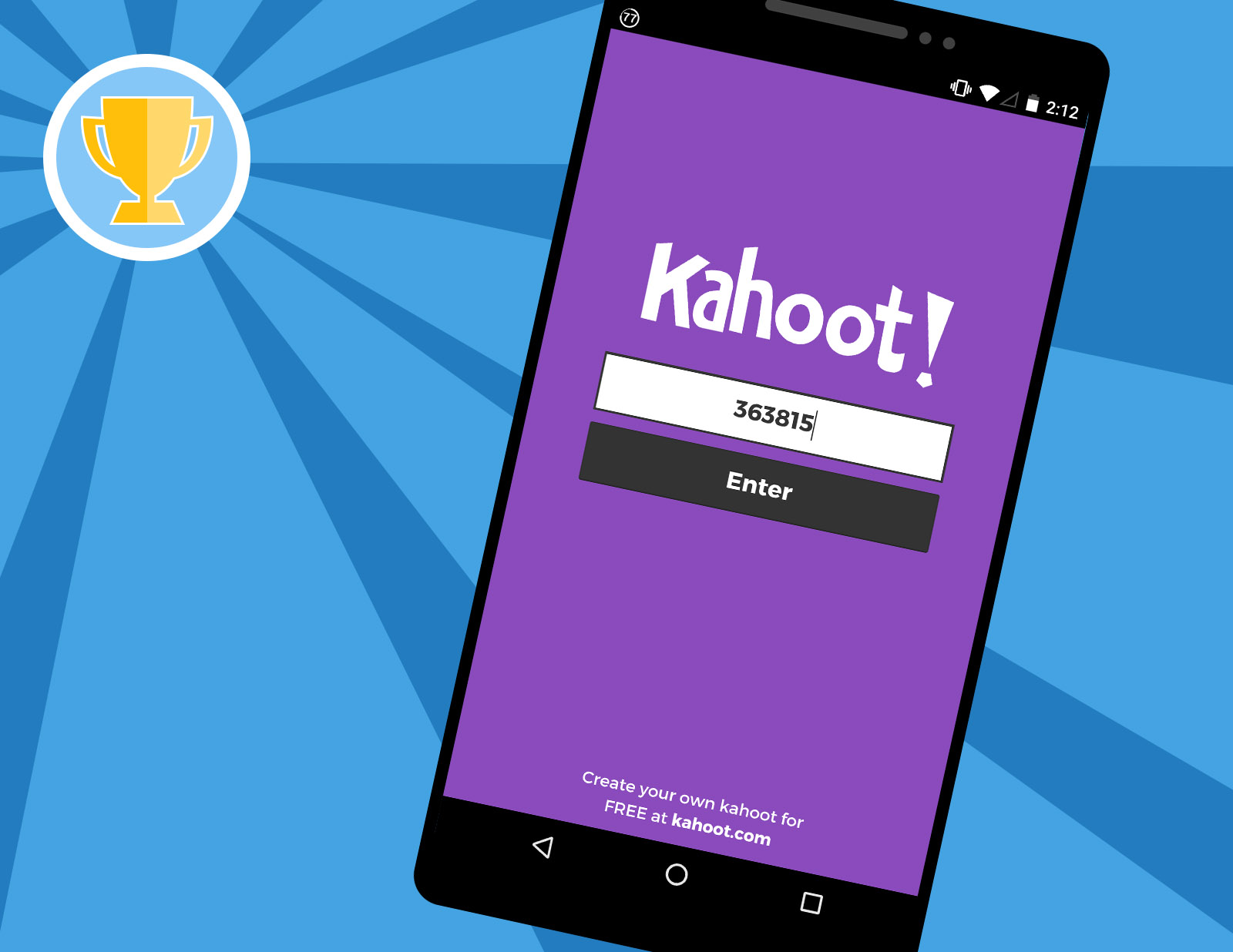
How To Make A Kahoot Game Pin
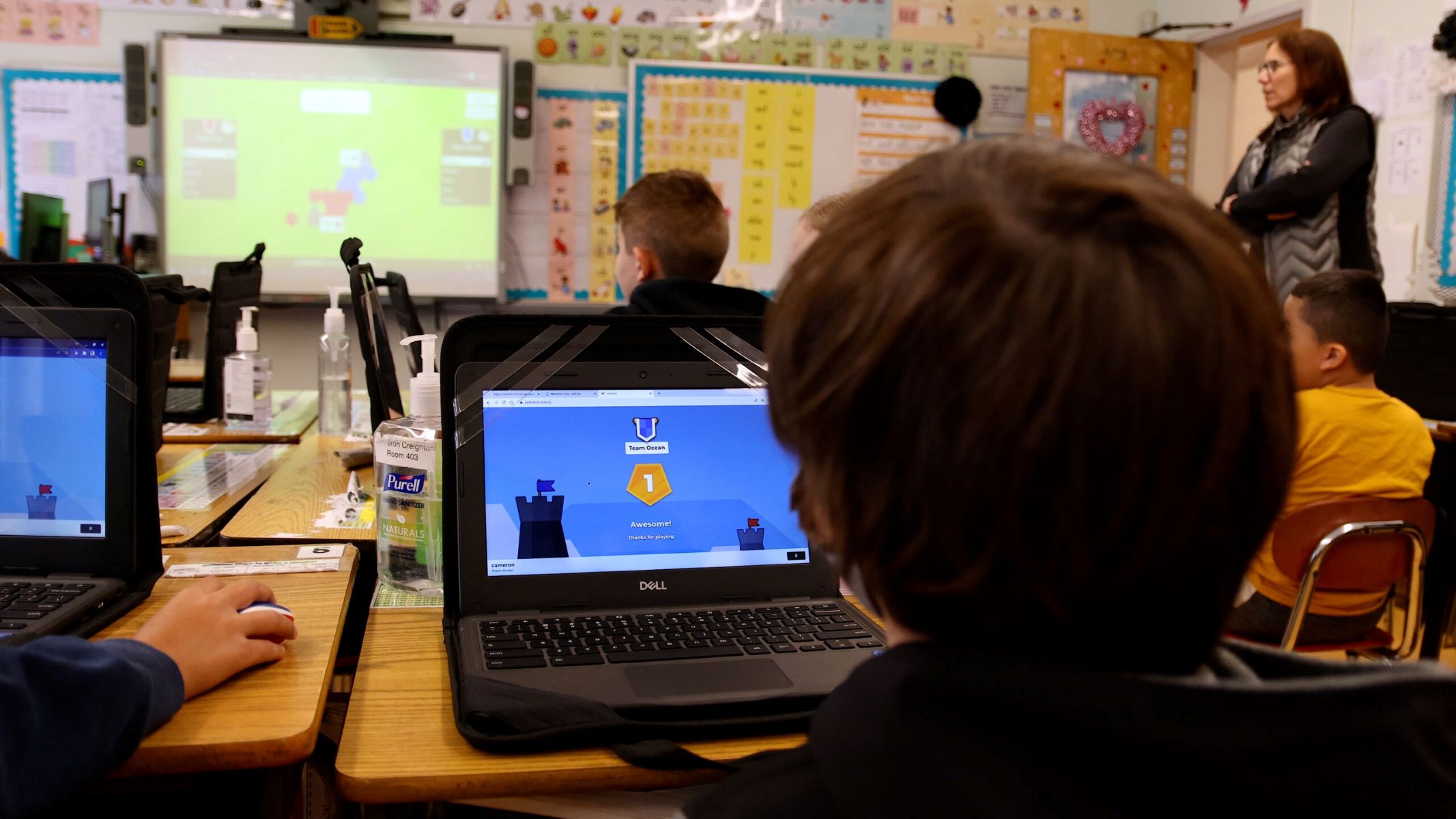
How To Play Solo Kahoot
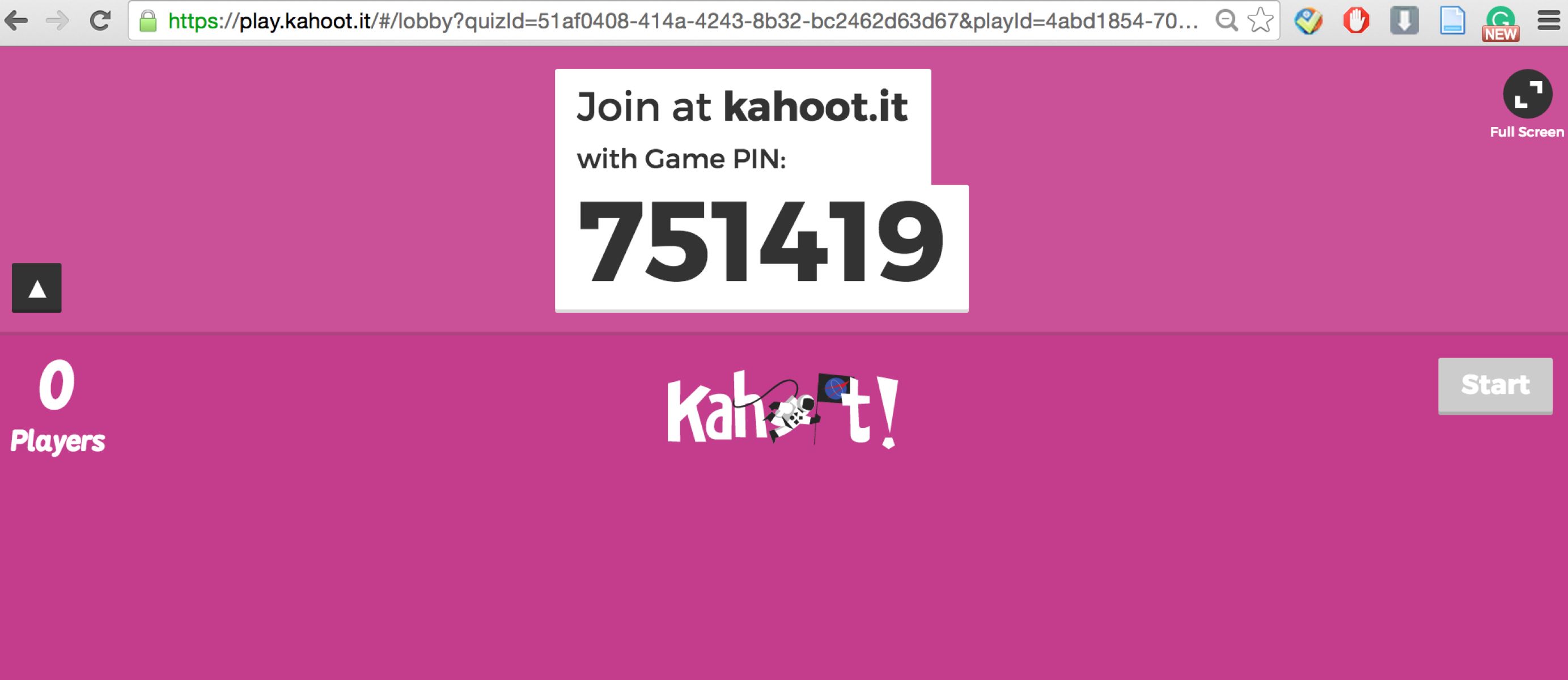
How To Get Kahoot Quiz Id
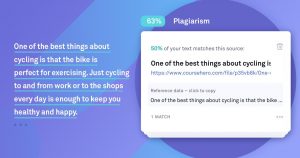
Is the Grammarly Plagiarism Checker Good? (A Review)

AI in Education: Definition, Examples, Benefits and Future
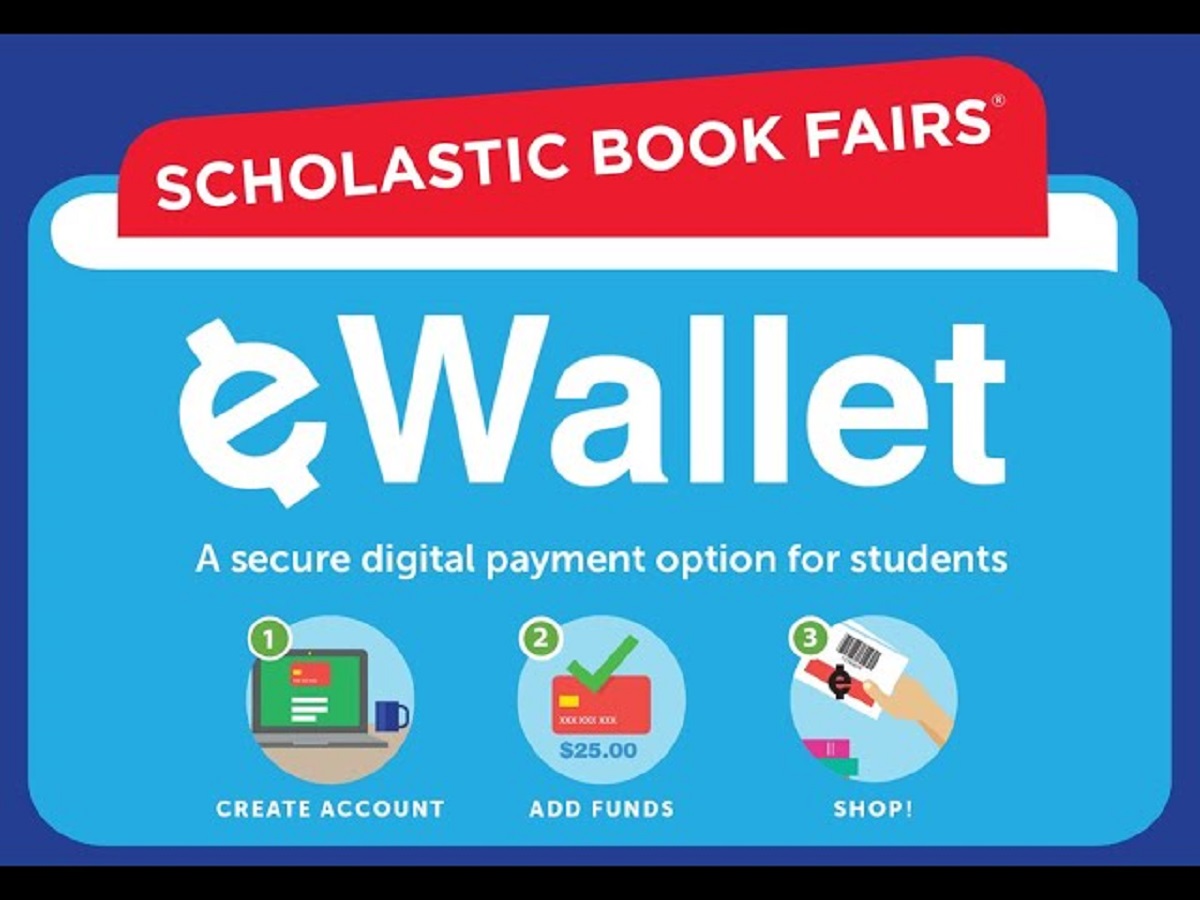
Scholastic E-wallet: How Does It Work?
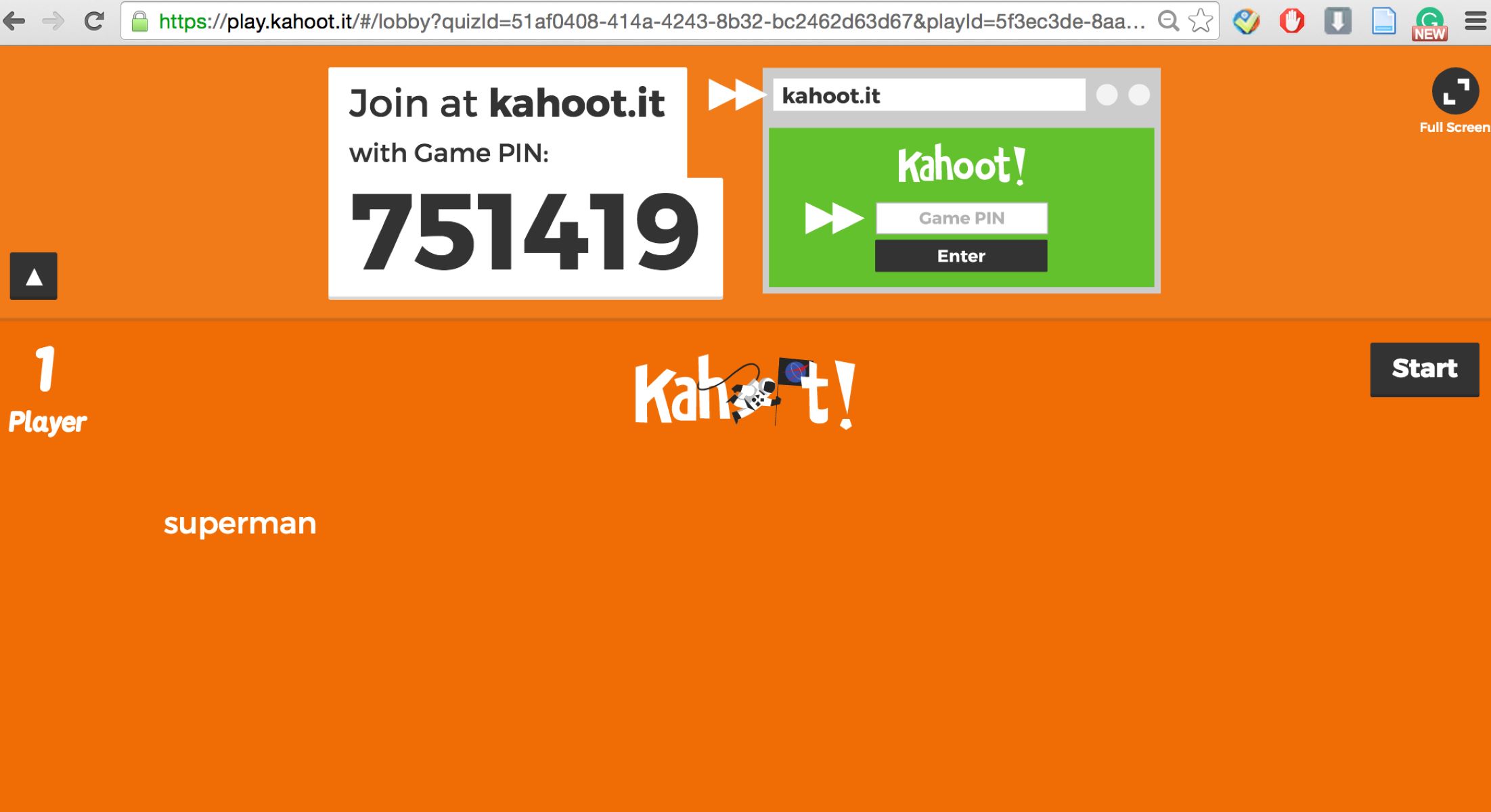
How Many Numbers In Kahoot Pin
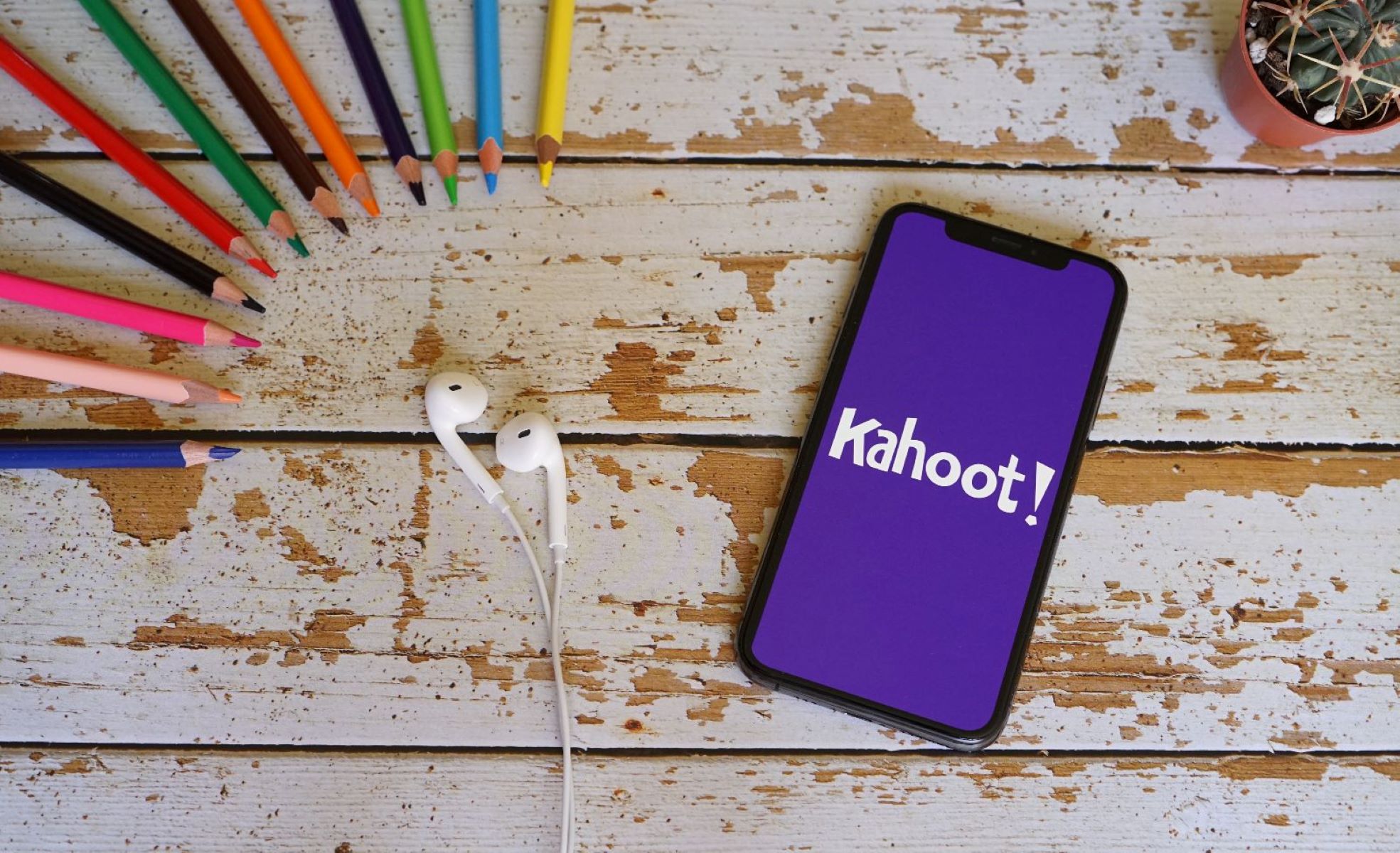
How To Start A Kahoot
Recent stories.

How to Find the Best Midjourney Alternative in 2024: A Guide to AI Anime Generators

How to Know When it’s the Right Time to Buy Bitcoin


How to Sell Counter-Strike 2 Skins Instantly? A Comprehensive Guide

10 Proven Ways For Online Gamers To Avoid Cyber Attacks And Scams

- Privacy Overview
- Strictly Necessary Cookies
This website uses cookies so that we can provide you with the best user experience possible. Cookie information is stored in your browser and performs functions such as recognising you when you return to our website and helping our team to understand which sections of the website you find most interesting and useful.
Strictly Necessary Cookie should be enabled at all times so that we can save your preferences for cookie settings.
If you disable this cookie, we will not be able to save your preferences. This means that every time you visit this website you will need to enable or disable cookies again.

No Closed Roads Inc.
Affordable tutoring for K-12 students

- Sep 19, 2019
How to Write a Good Email to a Teacher
Have you ever written an email to a teacher and received a late reply, or one that didn’t really answer the question you were asking? In less than a paragraph, your emails make an impression on the person reading them, which affects the timeliness and accuracy of their response. Whether you’re in high school or college, email communication with teachers and instructors is common. At some point, you’ll find yourself having a question about an assignment and composing an email to get this answer. Below are tips for sending excellent emails that will increase the chances you receive a quick and helpful response, while respecting the teacher’s time.

Note: “Instructor” and “teacher” are used synonymously in this article. If you’re writing to a high school teacher or college instructor, the same principles apply.
Use formal greetings
Many times, student start emails with “Hey” or no greeting at all. Always start with a greeting; this is friendly and courteous to the recipient. For example, start with “Dear Mr. Gonzalez” or “Hi Ms. Smith.” If you have never met the instructor or teacher before (maybe you’re trying to get into a full class or switch sections), always start with “Dear,” as this is more formal.
Dear [Name] ,
Hi [Name] ,
Good morning [Name] ,
Good evening [Name] ,
Use formal closing lines
Always include a send-off, especially in your first email. “Sincerely” is always a good option. “All the best” and “best regards” are also formal, appropriate options. Always include greetings and closings to make a respectful and courteous impression.
Sincerely, [your name]
Best regards, [your name]
All the best, [your name]
Personalize greetings with names and double check spelling
If you received an email with a simple “Good morning,” or “Hi,” would you feel like the email was personalized to you? Always include the person’s name in the greeting if you are sending it to a specific individual. Check your school’s website, the staff/faculty directory, or the syllabus for names. Always, always double check the spelling of names . A misspelled name can create a negative impression. Show the instructor you took the time to address them correctly.
Use formal titles, then follow suite
Unless your teacher or instructor specifically states they are comfortable with a first-name basis, always start formal. Particularly with college instructors, pay attention to how they sign off their emails. If they sign back, “Molly” or “Julio,” then you can address them by their first name in your next email (as they have referred to themselves this way). If you’re not sure what title to address someone by (e.g. “Dr.,” “Professor,” “Mrs.,” or “Mr.”), do a quick search on your school’s website, and check the syllabus. What title does this person use for themselves?
“Dear Dr. Morales” instead of “Dear Molly”
“Dear Mr. Johnson” instead of “Dear Julio”
Compose in Microsoft Word, not in the email program
Draft your email in a word processing software, not in the email program itself (i.e. don’t compose in Gmail, Outlook, etc…). It can be embarrassing if you accidentally hit send before you’re finished composing and proofreading the email. Composing in a word processing software allows you to run spellcheck and a grammar check before sending the email. Copy and paste the message into the email program when you’re done.
Provide context for the instructor
Especially in college, your instructors may have hundreds of students. Make it clear in your email which class and section of theirs you're in. Providing the specific class and section will help the instructor most quickly understand your request and answer efficiently. When they have to figure out what class you’re in, this eats up their time and will delay their response. For example, “I’m in your SOC 101, Sec. 8 class on MWF from 10-11am.”

Say thank you
Everyone likes being thanked. Your teachers and instructors are happy to help you, but they are busy. Acknowledge that their time (like yours) is valuable, and say thank you somewhere in your email. For example, “Thank you for your time” or “Thanks for your help; I really appreciate it!”
Want to create an even more positive impression? If you visit a teacher during office hours, send them a quick email thanking them for their time meeting with you.
Keep it concise
Leave it fewer than 150 words. This word count isn’t a hard and fast rule, but the more concise your email is while still including all the relevant information, the more likely you are going to receive a quick response. When teachers have to read through lengthy emails and determine what the student is asking, it takes more of their time. Being concise also forces you to think through what you’re trying to let the teacher know or what you’re actually asking.
Consider meeting in person
Can’t express what you’re trying to say in fewer than 150 words? Maybe an in-person visit is better. Office hours or one-on-one meetings with instructors can be a great opportunity to build a personal relationship with the teacher. Take advantage of office hours to get the most out of your school experience.
Proofread, spellcheck, and capitalize
When instructors receive emails in “text-lingo” with abbreviations, uncapitalized words (like “i”), and misspellings, this can portray the student as “sloppy” or “lazy.” You don’t want your instructor to think that you don’t care enough about the class to reread the email and catch these typos. Cast yourself as a professional, and use emails as practice for future workplace communication.
Write a specific subject line
One of the most important elements of an email is the subject line. The subject line immediately tells the recipient of the email what the message is about. Subject lines catch attention, and a clear, specific subject line is more likely to be answered correctly and efficiently than something vague like “Class” or “Question.” In your subject lines, include the class and specific request. For example, “ENGL 201: Question about homework” or “CHEM 112: In-person or Canvas submission for Lab 1?”
Here is an example email to a college instructor using these principles:
From: [email protected]
Subject: BIOL 112: Citation Style Preference for Paper 1
Dear Professor Gonzalez,
I’m in your BIOL 112 Sec. 002 course in Building 1, TTH from 1-3pm. For the BIOL 112 literature review assignment due Sept. 30, which citation style should we use? APA, MLA, or another style?
Thanks for your time and help!
Mindy Manners
Works Consulted/Additional Resources
Panter, M. (2019). How to write a professional email. AJE Scholar. https://www.aje.com/arc/editing-tip-professional-email-writing/
Potter, D. (2017). How to write a perfect professional email in English: 7 Useful Tips. Grammarly. https://www.grammarly.com/blog/professional-email-in-english/
Sehgal, K. (2016). How to write an email with military precision. Harvard Business Review. https://hbr.org/2016/11/how-to-write-email-with-military-precision
- For Students
Recent Posts
Breaking Down Burnout
How to Polish Up Your Presentation Skills
The Why's and How's of Note-taking

literature review assignment due Sept. 30, which citation style should we use? APA, MLA, or another style? http://rangersprotect.com/
Flow through your inbox
Flowrite turns your instructions into ready-to-send emails and messages across your browser.
.png)
For companies
Aug 8, 2022
How to email a professor with 22 different examples
Learn how to email your professor (and what to avoid doing) and check out 22 sample emails to help you get started.

Lawrie Jones
Table of contents
Is there anything more nerve-racking than sending an email to a professor?
Every student will need to send an email to a professor at some point, whether you're asking for an extension, explaining an absence, or a little extra help. But how do you write an email to a professor?
In this guide on how to email a professor, we break down the steps to writing better messages. You'll learn the structure of a good email to a professor (and what to avoid).
And if this is not enough to convince you that it's easier than you might think, we finish off by providing 22 sample emails to a professor!
If you want to impress your professor with perfect grammar, make sure to try Flowrite :
How to send an email to a professor
So, how do you write an email to a professor? Professors are professional people who will be used to traditional email etiquette. That's not to say that you can't introduce some individuality into your emails; it's just important to show respect.
You'll understand your relationship better than we do. You can be a little less formal if you feel it's appropriate.
Following the correct email etiquette is essential – and easy. In this article we break it down into steps to illustrate what we mean. We've also written about proper email etiquette on our blog before:
It's also important to keep emails short and to the point. Professors receive hundreds of messages daily and don't have time to delve too deeply to get the information they need. Say who you are, what you want, and why you're messaging upfront.
Should I send an email to a professor?
Classes can be busy, and a professor's time can be limited, so email is an ideal way to communicate with your Professor. Emails enable you to go into detail, create lists and spend time crafting a complex message.
If your question or comment is urgent or sensitive, consider whether it's better to book a meeting or pull them aside for a chat.
Only you can decide whether to email a professor.
How long should I wait for a reply?
Professors are people with busy lives and professional responsibilities, so you may need to wait for a reply. But how long should you wait for a response from your Professor?
There are no hard and fast rules on how long to wait for a reply, but the general rule is to give it two or three days before sending a follow-up. You can learn more in our guide on how to write a follow-up email.
Email format for messaging a professor
The email format for a professor should be familiar to anyone who understands the basics of messaging. Here's how it works:
• Subject line
• Body copy
• Signature
If you're unfamiliar with how to write a formal email, check out Flowrite blogs that delve deeper into what makes a great subject line, how to greet someone, appropriate sign-offs, and striking the right tone of voice.
Subject line for an email to professor
Your subject line should spell out exactly what your message is about. Why? Because professors get hundreds of emails daily, they'll need a reason to open and respond to yours.
We've provided some examples below.
How to greet a professor in an email
Professors should always be addressed using their titles. You can open an email in a few ways, such as:
• Dear Professor
• Hi Professor
Avoid casual openings, such as "hey" or "how are you doing?". Instead, always uses your Professor's title to show respect, even if you start an email with "Hi" or "Hello."
How to address professor in email
We've covered the importance of using a professor's title in an email, but there's more to it. When discussing how to address a professor in an email, we're talking about the tone of voice – and getting that right can be tricky.
You'll want to be personal, but being too familiar can cause problems. We've written before about how to hit the right tone, so start there. Our examples below show how we've put this into practice.
How to start an email to a professor
An excellent way to start your email is by stating who you are and explaining what your message is about. As we've established, professors receive hundreds of messages every day, so they'll skim-read your message. Unless you're clear with what you want, you could find it binned.
You can see 22 examples of how to address your emails and get to the point as soon as possible.
How to sign off an email to professor
There are several ways you can end an email you a professor. Traditionally, you'd use "your sincerely," but today, you can be a little less formal. Some safe email endings to a professor include:
• Kind regards
• Yours sincerely
Email to professor examples
So, we've explained the basics of emailing your Professor; now it's time to put it into practice with samples. Here are 22 email to professor examples that should cover any scenario. So, whether you're asking for advice, access to a class, or a little extra support, we've got a template for you.
22 sample emails to a professor
Here are 22 examples of how to email your Professor. These should cover a whole range of situations that you could find yourself in. As with all our templates, use them as inspiration, and be sure to adapt them to your specific situation.
Ready to get writing to your Professor? Then let's begin.
1. How to write an excuse email to professor example
2. how to email professor for extension example, 3. how to email professor asking for extra credit example, 4. how to email a professor about failing a class example, 5. how to send a follow-up email to a professor, 6. how to write a formal email to a professor example, 7. how to email a professor about getting into their class example, 8. how to email a professor about a grade example, 9/ how to introduce yourself in an email to a professor example, 10. how to ask professor to accept late assignment email example, 11. how to email a professor for a letter of recommendation example, 12. how to email professor about missing class example, 13. how to write a polite email to a professor example, 14. how to write a professional email to a professor example, 15. how to write a proper email to a professor example, 16. how to ask a question to a professor email example, 17. how to write a reminder email to professor example, 18. how to reply back to a professor's email example, 19. how to email a professor about research example, 20/ how to schedule an appointment with a professor email example, 21. how to email professor about being sick example, 22. how to write a thank you email to a professor example, closing words.
Writing emails to a professor can cause mild anxiety, but it doesn't need to be so. We hope that breaking down how to email a professor into steps and providing a massive number of samples will help.
It's essential to understand the principles of crafting professional emails, such as an email to a professor – now it's time to put it into practice.
Supercharge your communication with Flowrite
Write emails and messages faster across Google Chrome.
Explore Flowrite
.png)
Start using Flowrite today
Try it yourself
General template
Reply to: "
Received message
introduce flowrite short instruction to ready to send emails we finish email
Generate a reply
Generate an outreach
Share this article
Related articles

How to write a thank you email with 39 samples and template
Wondering how to say thank you? Our thank you email template and 30 thank you email examples will help you say thank you meaningfully.

How to ask for something in an email with 9 examples
Learn how to write request emails that get results with our in-depth guide. This article breaks down the process of writing request emails for information, documents, contact details, favors and more.

10 coolest new productivity tools of 2021
We went to find the best productivity tools so that you can skip the browsing and take them for a test drive.

We use cookies to analyze site performance and deliver a better experience for visitors.
%20(1).png)
Product updates
Read the latest →
%20(1).png)
About Flowrite
Get to know us →
Productivity

© 2023 Flowrite
Trending Post : 12 Powerful Discussion Strategies to Engage Students

Email Etiquette: Teaching Students How to Email a Teacher
Email etiquette can be one of the most beneficial writing lessons of the school year. Students make great gains in a short amount of time. Consider…
From: [email protected]
To: [email protected]
Subject: HOMEWORK GRADE!
Mrs. Hart,
Why didn’t you put in my assignment yet? I turned it in after school today, and my dad is jonesing me about it. I’m going to be grounded all weekend if you don’t put it in asap. I hope you didn’t lose it.
[Insert sigh of frustration.] Emails like these are all too common at the secondary level. I used to get upset after reading one. I’d think, The nerve! How disrespectful. Who does this kid think he or she is? Stewing over it got me even more worked up.
One day, I had a heart-to-heart with a good student about an extremely rude email. During our conversation, she looked at me like a deer in headlights, and I could see she was completely unaware of the unintended tone of her message.
Later that day as I reflected on the bad email epidemic and this particular student’s response, it dawned on me. They’ve never been taught. And it’s true. Many students who sit in our classes after year have never been taught how to write an email to a superior (boss, teacher, or anyone else who would be addressed in a high-register tone).
So. I started teaching email etiquette. And guess what? Lo and behold…it worked (mostly). While teenagers are still learning how to master tone (we have to give them a little leeway and use teachable moments when they arise), we can’t expect teens to be able to intelligently and respectfully communicate with adults in a language that is somewhat foreign to them if we don’t give them the tools to do so.
WHY TEACH EMAIL ETIQUETTE
First and foremost, no one appreciates receiving a rude email.
However, it’s also a form of communication that is highly valued in our society, both in personal and professional realms. We are living in a digital age where online communication skills are essential to success. Did you know that 99% of people check their email daily, and over half of those people check it before social media? Most of these individuals refresh their inboxes multiple times a day. No doubt, it’s a dominant way humans speak to one another.
In a school environment, direct instruction about email etiquette provides background students will need to discuss author’s tone and writer’s voice throughout the year. Plus, it coincides SO WELL with any digital citizenship and career readiness lesson. Are students aware that as soon as they press “send,” that email is part of their permanent digital footprint?
Beyond high school, secondary teachers need to empower students to succeed in college and the workplace. One day, they won’t have anyone to teach them how to write an email that conveys their message respectfully. They’ll just need to know how to do it as a professional in the workplace! We need to seize the opportunity while we can and set the stage for them to be successful in life.
Then, there’s relevance. Email etiquette is a skill in which students should find value. Often, we hear, Why do we even have to learn this? When are we ever going to use this in life? With this topic, students should see the direct connection to their lives and understand how much it will benefit them.
WHEN TO TEACH EMAIL ETIQUETTE
While email etiquette could be addressed at any point during the year, I often use it as my back-to-school writing unit . In doing so, I experience fewer unpleasant communications during the remainder of the year, and students benefit by knowing how to confidently email their teachers all year long. Not only will reading their communication make your life easier, but also your colleagues will thank you for making their lives easier.
In middle and high school, students begin to email their teachers more frequently, so these are the ages where this type of lesson would be crucial. Because email genre is one that transcends subjects, it lends itself well to cross-curricular study opportunities.
If your students communicate mostly via a learning management system chat function, these same guidelines apply!
HOW TO EMAIL A TEACHER: 4 BEST PRACTICES
1. establish criteria..
How is a student to know what is acceptable and what is not without a list of guidelines? I begin my email etiquette unit with practical tips that teenagers can apply to their own writing in order to sound more professional and respectful. At first, we use the tips I introduce to them, but soon enough, students are adding onto that list with some ideas of their own. And I love it! From there, we move on to evaluating texts based on those criteria.
2. Use engaging examples.
Most students have probably broken one or two etiquette rules in the past. The last thing I want to do when covering a subject like impolite emails is resort to shaming, so I keep it light. I use humorous (and often over-the-top) #EmailFail examples mixed with more down-to-earth and realistic ones. As a class, in small groups, and individually, we read, analyze, evaluate, discuss, and revise the model texts. Supplementing with video clips is an additional way to differentiate and make the content more interesting to twenty-first century learners.
3. Provide an authentic audience.
It’s difficult for students to truly take a writing assignment seriously if they don’t have an authentic audience. A best practice with writing is to have the students actually send the email to the recipient. In doing so, I’d strongly encourage you to either make yourself the recipient of an email in response to a fabricated scenario or to read through students’ drafts before allowing them to press “send” to another teacher (for obvious reasons).
In the past, I’ve asked students to think of a class they have strong feelings about in the moment. (We need to harness real emotions in order to help students understand how to channel and word them respectfully.) Maybe they are angry because the teacher just assigned a large project. Perhaps they are worried because it’s a speech course, and they are deathly afraid of public speaking. Or it could be that they just hate math…have always struggled with it…and are concerned about being pushed too far out of their comfort zone. I then ask them to draft an email to the instructor of that course, which leads us to best practice #4.
4. Give immediate feedback.
The easiest and quickest way for students to learn what’s acceptable and what’s not is if I go over their draft with them right then and there. I read it out loud so we can both hear it as the sender would interpret it. This way, their intended tone is not apparent, and I point out areas for improvement. For example, in her email, my student Jacky might have written something like:
Dear Mr. Stine,
I was wondering if you’d be willing to move the science test back another week? I have been studying on my own, but the study guide you provided is not very helpful, and I don’t feel like we’ve covered the information well enough in class. Some of my friends have also expressed similar concerns, and we all think an extension of the test date is in order.

While Jacky’s email might follow a lot of the obvious, more minor guidelines for email etiquette, I would conference with her about how she could word her concerns in a tone that would win the audience over to her side rather than alienating the instructor by putting him on the defensive.
The number one comment I find myself repeating to students as I conference is this: Would you say this to their face? No? Then we need to word it differently in writing. Like text messaging or commenting on social media, it’s easy to make hurtful and even mean remarks when you’re separated from the audience by a digital wall.
Year after year, parents report to me that immediate feedback through conferencing is the number one factor in helping their children grow as writers. It’s in this safe place that we can be honest, we can provide real-time feedback, and students can make improvements to their writing.
EMAIL WRITING AS A PRE-TEST
No one wants to start the year with a stack of papers to grade. Actually, people generally don’t like stacks of paper at any time of the year. Yet, in order for students to really understand email etiquette, they need practice and repetition. So. How do we grade it without overwhelming ourselves?
We can start by asking a simple question: What’s the purpose of this unit? In short, the goal is to help students communicate more politely in writing. What’s the best way to teach them? In class – through practice and conferencing. Therefore, most of the “grading” takes place through discussion.
Teaching students about email etiquette doesn’t have to add to equate to a mountain’s worth of grading. Plus, by allowing students a free space to experiment, be vulnerable, and receive feedback that doesn’t hurt their grade, an invaluable risk-taking platform develops; consequently, it creates a writing culture in which students feel confident and free to toy with their skills.
Many teachers begin the year with pre-tests, and I have as well. Formal writing pre-tests have value, but I find them more appropriate in small-group settings, for intervention, or with tutoring. Besides, trying to grade a stack of essays (even in the form of emails) at the beginning of the year is overwhelming. It’s not fun to start the year feeling behind.
Since the goal of pre-tests is to help teachers gear their writing instruction, teachers can use email etiquette lessons to inform their future writing instruction. As you read students’ email drafts and conference with them, you can keep a list of common errors you notice and use this information, which is gained in an authentic way, to decide where you want to begin your formal writing lessons.
FINAL THOUGHTS…
Remember poor late-work Vinny? What if his email had sounded like this?
Dear Mrs. Hart,
I am so sorry for not turning in my “Scarlet Ibis” reading response on time. It’s my responsibility. I submitted it at the end of the day today, but I didn’t see you in your classroom. I just want to make sure you received it. Can you verify? Thanks so much in advance for your time in responding, and I apologize for the inconvenience.
Do your students have any experience with writing formal emails to teachers, bosses, or other superiors? Do you receive emails from students which could be more professional? Will your students be applying for a job one day? Students of all subject areas and grade levels can benefit from some engaging #EmailFail and Email Etiquette 101 lessons . Let’s help ourselves by helping our students hone real-world writing skills that will give them a competitive edge. You might be surprised how many of your students will thank you in return.
- Teaching Students to Avoid Plagiarism
- Ways to End the Year Well
- Playlist of My Year – An Engaging Writing Activity
RELATED RESOURCE SPOTLIGHT
You can view the materials I use in my classroom here . Use it to complement your own email etiquette materials or as a complete unit.
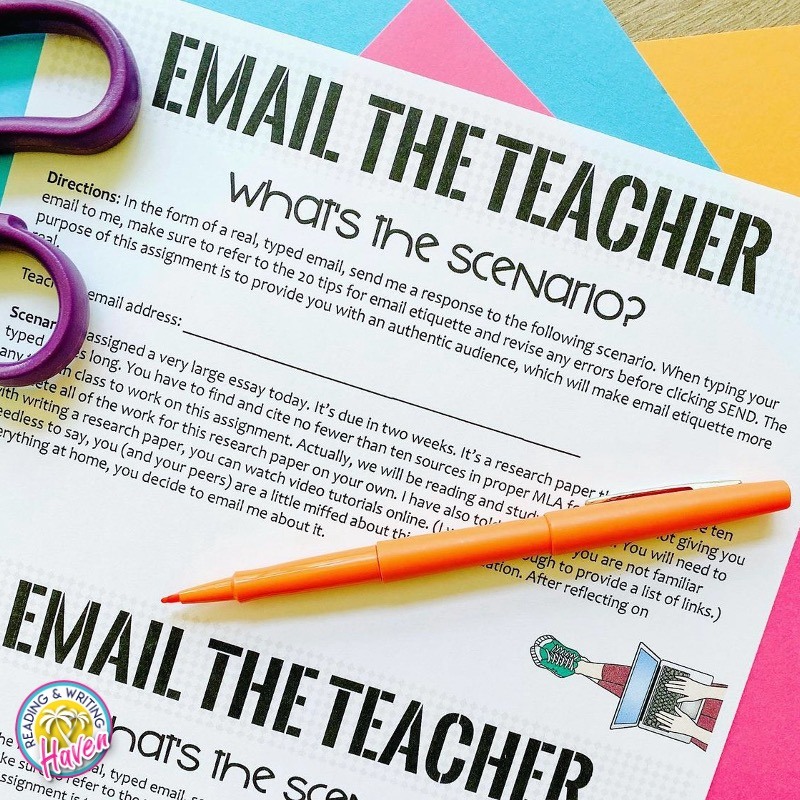
If you need a FREE writing survey to gather information about your students’ interests, you can find the one I like to use here .
Happy teaching!
You may also enjoy...
Get the latest in your inbox.
- PRO Courses Guides New Tech Help Pro Expert Videos About wikiHow Pro Upgrade Sign In
- EDIT Edit this Article
- EXPLORE Tech Help Pro About Us Random Article Quizzes Request a New Article Community Dashboard This Or That Game Popular Categories Arts and Entertainment Artwork Books Movies Computers and Electronics Computers Phone Skills Technology Hacks Health Men's Health Mental Health Women's Health Relationships Dating Love Relationship Issues Hobbies and Crafts Crafts Drawing Games Education & Communication Communication Skills Personal Development Studying Personal Care and Style Fashion Hair Care Personal Hygiene Youth Personal Care School Stuff Dating All Categories Arts and Entertainment Finance and Business Home and Garden Relationship Quizzes Cars & Other Vehicles Food and Entertaining Personal Care and Style Sports and Fitness Computers and Electronics Health Pets and Animals Travel Education & Communication Hobbies and Crafts Philosophy and Religion Work World Family Life Holidays and Traditions Relationships Youth
- Browse Articles
- Learn Something New
- Quizzes Hot
- This Or That Game New
- Train Your Brain
- Explore More
- Support wikiHow
- About wikiHow
- Log in / Sign up
- Computers and Electronics
- Online Communications
- Writing Emails
How to Email Professor About Late Work
Last Updated: January 30, 2024 Fact Checked
This article was co-authored by Alexander Ruiz, M.Ed. and by wikiHow staff writer, Caroline Heiderscheit . Alexander Ruiz is an Educational Consultant and the Educational Director of Link Educational Institute, a tutoring business based in Claremont, California that provides customizable educational plans, subject and test prep tutoring, and college application consulting. With over a decade and a half of experience in the education industry, Alexander coaches students to increase their self-awareness and emotional intelligence while achieving skills and the goal of achieving skills and higher education. He holds a BA in Psychology from Florida International University and an MA in Education from Georgia Southern University. This article has been fact-checked, ensuring the accuracy of any cited facts and confirming the authority of its sources. This article has been viewed 133,270 times.
With deadlines, jobs, activities, and relationships to juggle, managing your schedule as a student can be tough. If you’ve realized you’re going to miss a deadline (we’ve all been there), you might be wondering how to email your professor for an extension, to apologize, or to limit any late penalties. Don't worry, we've got you covered. Below, we'll walk you through how to email your professor, plus we'll give you some sample emails to inspire you, too. To learn how to email your professor about late work, read on!
Tips For Late Work Emails

- Don’t say: “I’m just genuinely so, so sorry. I can’t believe I turned this in late, and you have no idea how long I prepped for this assignment. I really am so sorry that I missed the deadline, and you should know that I will do my best in the future, even when I have tech issues, to not let this happen again.”
- Instead say: “I apologize for turning in this assignment late. Know that I take my work seriously and I’ll do my best to avoid this in the future.”

- Don’t say: “Message from a student in Psych 104,” “Need an extension,” or “Hello from Randy Bernard!”
- Instead say: “Extension Request for Psych104, Paper 2: Randy Bernard”

- Use a formal greeting. “Dear Professor James,” and “Professor James,” are perfect. “Hey,” and “Hi,” are too informal and should be avoided.
- Same goes for your signoff—choose a formal phrase. “Best,” and “Sincerely,” are great picks.
- If you’re asking your professor for something, be sure to ask, not demand. Instead of saying “I need” an extension, say that an extension would be extremely helpful to you.
- Remember to use “Please” and “Thank you," too!

- This could hurt your relationship and increase penalties on your assignment.
- So instead, say you're sorry: “I apologize for my late assignment. I know you're busy, and I don’t want to waste your time.”
- “I’m sorry for this late paper, especially because it communicates a lack of care and concern for my grades that I don't feel is accurate.”

- “If I had an extra 48 hours to complete this assignment, I’d be able to fully explore and structure my insights for this term paper.”
- “I would greatly appreciate an extension on this project. With a little more time, I could turn in my very best work and learn even more from this assignment."

- “Last night, my dog had a bar of chocolate without me realizing. I’ve spent the entire evening with her at the vet.”
- "To be entirely honest, I've been dealing with some mental health issues that are seriously affecting my schoolwork."
- If you can, avoid lying. If you're granted an extension and the truth comes out later on, you could face major consequences.

- Don’t say: “Honestly, it was out of my hands entirely. I’m a victim of circumstance, and that’s why my assignment is late.”
- Instead say: “It's true that I didn’t plan for this to happen. That being said, if I’d started earlier, this wouldn’t have been an issue. So I know, ultimately, this is my fault. I take full responsibility.”

- “This isn’t like me, and in the future, I promise to do better.”
- “I take my schoolwork very seriously. If it weren’t for my dog’s illness, I would have made getting this assignment in my top priority.”

Sample Emails

Why You Should Email Your Professor About Late Work

- Policies around extensions differ from school to school, but by writing an A+ email, you can only help your chances.
- Generally, professors only give you an extension under extenuating circumstances, like a major accident. They're going to be less inclined to extend an assignment if you had competing priorities, like work.
- Professors are people too, and they want to help! Especially if you don’t have a history of late work, when you plead your case, they may be more forgiving than you’d expect.

- Especially if you had a major, unforeseen factor pop up in the final moments before submitting your assignment, you may be able to explain and limit your punishment.

- By offering a respectful and honest apology for your late assignment, you can improve your relationship with your professor, earn their respect, and possibly limit your late assignment’s penalties.
Expert Q&A

You Might Also Like

- ↑ https://dean.williams.edu/files/2010/09/Guide-to-Emailing-Professors-1.pdf
- ↑ https://advising.yalecollege.yale.edu/how-write-email-your-instructor
- ↑ https://studentaffairs.loyno.edu/health-counseling/university-counseling-center/news-ucc/emailing-your-professor-tips-tricks-health
- ↑ https://www.bestcolleges.com/blog/how-to-ask-for-an-extension/
- ↑ https://www.makemyassignments.com/blog/how-to-complete-your-assignments-before-the-deadline/
- ↑ https://www.insidehighered.com/advice/2019/09/23/tips-handling-missed-deadline-opinion
About This Article

- Send fan mail to authors
Is this article up to date?

Featured Articles

Trending Articles

Watch Articles

- Terms of Use
- Privacy Policy
- Do Not Sell or Share My Info
- Not Selling Info
Keep up with tech in just 5 minutes a week!
- Grades 6-12
- School Leaders
FREE Poetry Worksheet Bundle! Perfect for National Poetry Month.
4 Sample Email Templates for Busy Teachers
Use these and finally clear out your inbox.
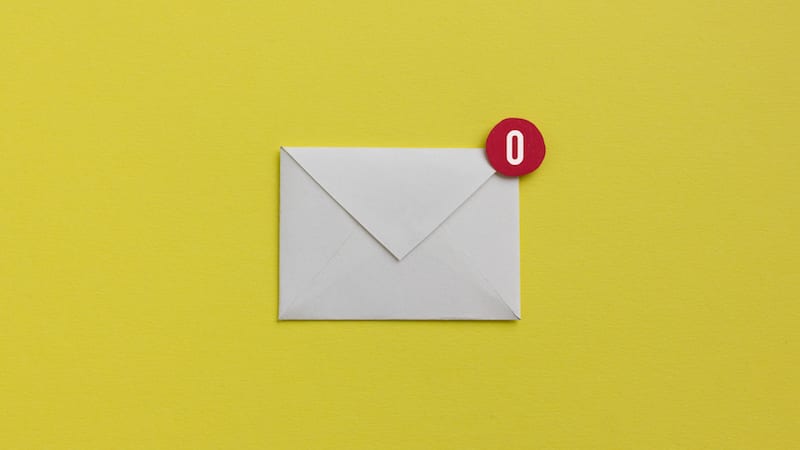
It’s a truth universally acknowledged that teacher emails, like Gremlins, multiply if you aren’t careful. If you get work emails at the rate I do, then you know how the constant back-and-forth can take up a big chunk of your work day, not to mention your Scandal-watching time.
Emails can also be a minefield of social awkwardness where you spend forever trying to find a tactful way to explain why Little Suzy missed recess today.
Below are some ideas and email templates to help you save your precious time and even more precious sanity.
First, some ground rules for quicker email writing in general:
- Get in and out. Be polite and include greetings and closings, but don’t feel like you need to write a long response just because you were sent a long email.
- Use the same greeting and closing every time. I give some examples below, but I start every email with “Dear so-and-so” and end every email with a simple “Best.” Make them something you don’t spend time ever thinking about.
- Watch your response time. Many people feel obligated to answer emails as soon as humanly possible, but that just speeds up the pace and number of emails in your life. It also teaches people to expect your reply right away. By waiting to respond a few hours later, you give yourself more time to respond thoughtfully and a much-needed break from the constant back-and-forth.
Email Template #1: Changes to the Schedule
From parents who have to pick their child up early (or drop them off late) to staff meetings, team meetings and meetings to plan other meetings, a good 80% of my inbox is email about scheduling.
Below is the fastest way to say, “Got it!” while still remaining polite.
Good Morning,
Thanks for letting me know. I have added it to the calendar.
Email Template #2: TLDR (Too Long; Don’t Respond by Email)
Sometimes you get a super-long email, often right after dinner time, where a parent has some thoughts they need to share with you, urgently . It often starts with, “Little Johnny came home from school today and said…” This parent clearly has many questions about an incident or failed test or some other concern that just occurred to him or her at 7:35pm on a Tuesday night.
It’s only natural to want to address their questions right away to both correct the historical record and offer your thoughts. But save time and sanity by waiting until morning and offering to set-up a phone or in-person meeting instead.
Having a conversation, rather than going back and forth by email, has a number of advantages. Not only does it save time, but it also eliminates the danger of inadvertently striking the wrong tone about a sensitive subject in email. Plus, if necessary, it also makes a space for an amped-up parent to calm down before you speak.
Dear Parent Name,
Thank you for being in touch. I think it’s best if we have a conversation either in person or by phone. I’m available the following times this week:
Monday, May 14, 2018: 1pm-1:15pm or 3:30pm-3:45pm
Tuesday, May 15, 2018: 9:30am – 9:45pm*
Please let me know which time works best for you.
*I’ve found that giving only a few choices makes setting-up an appointment easier and setting a clear end time ensures you don’t spend your entire prep on the phone.
Email Template #3: Sorry for the Delay
Being human and all, we can sometimes take a little bit longer responding to an email than normal. I’m of the opinion that answering non-urgent emails within 36 hours is acceptable, but if I take longer than that, I start my emails like this:
Thanks for your patience while I got back to you on this…. [Insert reply to original email here].
Email Template #4: The Gentle Nudge
A good friend has a job where she has to constantly remind people that they haven’t paid their bill on time or haven’t sent the documents they promised. She swears that you can get away with asking for anything if you begin your request with, “just a friendly reminder.” It totally works!
Good Afternoon,
Just a friendly reminder that [Jimmy has not yet turned in his permission slip for our field trip]. Could you please [return a signed permission slip] by [Friday/ as soon as possible].
I appreciate your help with this!
We’d love to see the email templates you use most often! Come and share in our WeAreTeachers HELPLINE group on Facebook.
Plus, how to respond to an angry message from a parent.
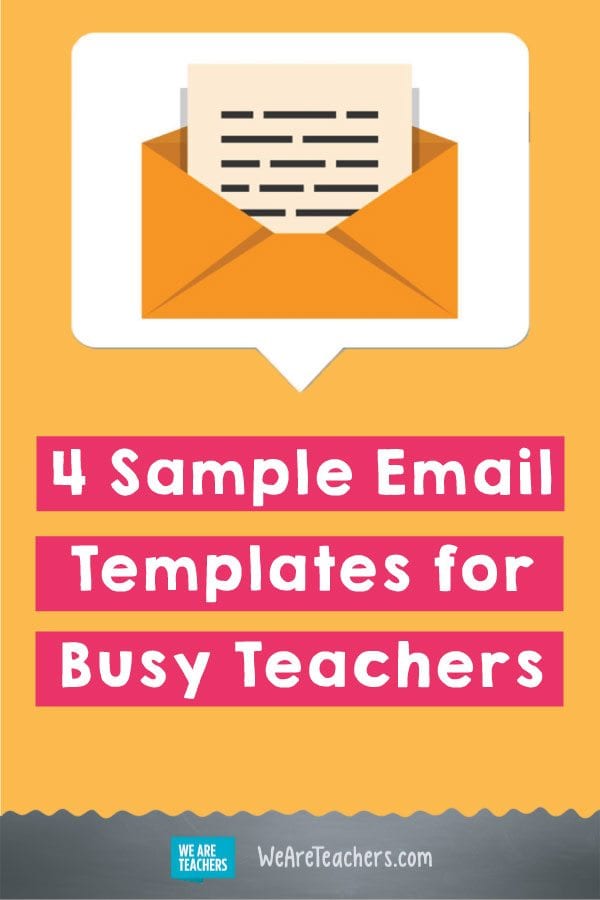
You Might Also Like

How to Get Teacher Travel Discounts
Because you deserve a vacation. Continue Reading
Copyright © 2023. All rights reserved. 5335 Gate Parkway, Jacksonville, FL 32256
Mental Health at Iowa

Release the Hamster: 8 tips for Embracing the Simplicity of Self-Care
Today I sat in the waiting room with my tween daughter, hurrying from home to be on time. Normally, I pull out my phone and read endless work emails or scroll through another high-drama news story.
Sound familiar? I feel like I am a hamster on a wheel, worried if I slow down, I may not be as put together as I hope to be.
I stepped off the “wheel” and looked at her ever growing, sweet face. I listened to her tell stories about her friends, teacher, and the next social dilemma she was pondering. Fifteen wonderful minutes without chores, homework, or email. We laughed and shared stories. When her name was called, she held my hand, and she wasn’t embarrassed as she walked toward the nurse. Smiling the whole way. My heart soared.
“Self-care” sometimes feels like something I need to plan or clearly identify as time for myself. But it can be so simple. There are many precious moments when you can pause to fill your bucket or at least jump off the wheel.
- Give yourself grace . We don’t have to do it all.
- Take a mental health day, don’t wait for the next holiday break or summer. You don’t need physical symptoms to justify taking care of yourself. A mental health day isn’t weakness or being “unwell.” It is a position of health and self-care. Embrace it.
- Practice mindfulness: Be present . Multi-tasking only allows us to be partially involved in several things.
- Adjust your expectations. Maybe for today, maybe for the next year.
- Practice self-care with someone else. Step outside for a quick walk, shut off the computer, or walk to a colleague’s office or classroom to just say hello .
- Validate. We don’t always need to teach or fix. Sometimes we just need to listen . This is my favorite teaching video .
- Find your happy. Know what brings you joy and do more of it. What did you enjoy 10 years ago? 5 years ago? What have you always wanted to try? Do it.
- Time is precious, take advantage of telehealth therapy and doctor’s appointments. Better yet, take the time away from the screen to see someone in person. Connect .
The Employee Assistance Program is dedicated to supporting the well-being of our faculty, staff, postdocs, and medical residents with confidential, short-term counseling; consultation for supervisors; and referral to community resources. For more information, resources, or to schedule an appointment, visit the UI EAP web page .
Cover image by Oleg Illarionov.
Texas Tech Now
Philanthropy, generous donation founds texas tech’s first veterans legal clinic.
April 2, 2024

The gift will also establish a new scholarship for full-time students in the Edward E. Whitacre Jr. College of Engineering who are employed.
A $1.6 million donation from the William A. Brookshire Foundation to Texas Tech University will found the Texas Tech School of Law Veterans Clinic – a service free to veterans that provides for their legal needs. The gift will also offer a first-of-its-kind scholarship at Texas Tech for working students in the Edward E. Whitacre Jr. College of Engineering .
“Bill Brookshire, the founder of the William A. Brookshire Foundation, was committed to helping students who help themselves, work hard and simply need extra assistance to be successful,” said Dean Quinn, a Texas Tech alumnus and member of the foundation's board of directors. “Dr. Brookshire worked all the way through school including while earning his Ph.D. in chemical engineering. Working students and military veterans were passions of his. The Brookshire Foundation is excited to partner with Texas Tech to help future engineers succeed and provide assistance to those students who have served our country.”
Texas Tech School of Law Veterans Clinic
The foundation, Texas Tech, and School of Law all have a long-standing commitment to military veterans. Additionally, these funds will further Texas Tech's strategic goal of transforming the lives of communities through strategic outreach.
“This gift represents extraordinary and innovative support by facilitating invaluable legal assistance to veterans in need,” said Texas Tech President Lawrence Schovanec . “It has been a privilege and honor to work with Lori, John and Dean to develop this clinic in the Texas Tech School of Law and also to witness their generosity in providing scholarships for students in the Whitacre College of Engineering.”
Funding for the new Texas Tech School of Law Veterans Clinic creates what will be the only pro bono clinic in West Texas dedicated solely to veterans. It will also provide operating costs, funds for hiring a world-class director for the clinic and will pay for remodeling needs in the existing clinic space.
The Veterans Clinic will accept referrals from the VA hospitals in Lubbock and Amarillo and aid veterans with advising on benefits, reclassifying incorrect discharge paperwork, and other civil matters they might face. The clinic also will provide hands-on training and experience for aspiring lawyers – ones who likely have an interest in continuing their work for veterans once they become licensed.
“This foundation has done something truly amazing for the people of West Texas and the School of Law,” said Dean of the School of Law Jack W. Nowlin . “Their generosity has made it possible for us to fulfill a vital need in the community and provide a fantastic training ground for our students. I'm excited about partnering with them to make a positive impact on the lives of veterans in West Texas.”
Edward E. Whitacre Jr. College of Engineering Scholarships
In addition to the commitment to military veterans, the foundation has been dedicated to helping hardworking students achieve their dreams of a college education.
The scholarship will support students in the College of Engineering who are working while attending college full-time. Currently, more than 60% of students in the College of Engineering work while maintaining status as full-time students.
The scholarship will provide $7,500 per academic year to 10 juniors and seniors in the College of Engineering whose combined enrollment and working hours are greater than or equal to 30 hours per week. Through this gift, the foundation is helping to alleviate the financial burden that comes with attending college and allowing students to focus more on their studies.
“We are grateful for this important support to an often-overlooked student population who many times struggle to manage all priorities,” said Dean of the College of Engineering Roland Faller .
You may also like
Texas tech awarded approximately $2.5m from doe for cybersecurity center, texas tech’s honors college launches new program, a global impact.

Missing Assignment Email to Teacher: 25 Example Emails
Want to reach out with a Missing Assignment Email Template to your Teacher? Here are some professional email templates:
Start with “Dear Teacher” or “Dear Mr/Ms[name]” Then proceed with
1 |I am writing this email to inform you that I forgot to submit my assignment. It was due today, but I didn’t have time to finish it in time. I apologize and I hope you understand.
2| I am very sorry to report that I have not completed my homework yet. I did not have time after school today and would like to do it now. I am sorry for submitting it late.
3 | I apologize for my late submission today. My little brother was sick yesterday and needed to go to the doctor, so I stayed home with him. Thank you!
4| I apologize for not submitting my missing assignment to you. I was facing some issues with the assignment and hence could not submit it to you. I am very sorry for this mistake, but I hope you can understand that it was beyond my control.
5|I am sorry for not submitting my assignment. I have been feeling unwell and didn’t have time to finish it. I should have it completed by tomorrow morning. Thank you for your time and patience in this matter.
6|I did not submit my assignment on time because I forgot about it. However, I have done it now, and you can find it attached below. Please accept my apologies for taking so long to get it to you.
7|I am sorry for not submitting my assignment. I know that this is unfair since it is due on Monday, and I would like to apologize to you. I am extremely sorry for the delay and hope you can give me some time to finish it.
8|I’m sorry for the delay in submitting my assignment. I have been busy and have had trouble finding free time to complete the assignment. I plan on getting it done next week and resubmitting it.
9|I’m sorry I have not completed the assignment, I will do it immediately.
10|I am sorry, but I will try to submit it as soon as possible.
11|I’m sorry I didn’t submit my assignment. I was busy with other things but I will submit it asap. Thank you for understanding.
12|Sorry for not submitting my assignment. Here is a corrected version of the missing assignment, along with an explanation of the situation that caused me to miss the deadline.
13|I am writing this email to inform you that I forgot to submit my assignment. It was due today, but I didn’t have time to finish it in time. I am sorry for the inconvenience and I hope that it will not affect my grade.
14|I apologize for not submitting my assignment to you. I must have missed the email announcement. I will be more careful next time. I apologize for being so careless in the future please forgive me.
15|I’m sorry for not submitting my homework. It was a mistake on my part and I apologize. Thank you for being understanding.
16|I apologize for not submitting this assignment.
17|I just realized that I missed the assignment. I am very sorry and have it submitted by tomorrow.
18| Dear teacher, I just realized that I missed the assignment. I am very sorry and have it submitted by tomorrow.
19| I am sorry I have not submitted my assignment, this is my first time having an email sent to you, hopefully, it is better next time. Yours sincerely,
20| I am so sorry for not submitting my assignment which is due on 2024. I did not have time to do it as I did not know where to start and therefore was not able to complete it on time.
21|I am sorry to report that I have not completed my assignment. While I am fully aware of the importance of completing my work and contributing to the class as a whole, extenuating circumstances beyond my control have prevented me from getting started. Please accept my apologies and know that I will make every effort to correct this situation while maintaining a high level of performance in all other aspects of your class.
22|I’m sorry for the delay in submitting my assignment. I apologize and will ensure this does not happen in the future.
23|I apologize for not submitting the assignment. It was an oversight on my part and I will double-check to make sure it is submitted tomorrow.
24| I am sorry for not submitting my assignment on time. It has been a busy week at school and I hope you can forgive me for this mishap. I will make sure to submit it immediately.
25| I would like to express my sincere apologies for not submitting my assignment on time. I understand that this is unacceptable. I sincerely apologize for the delay.
Close off your email with something like:
- Thank you for your consideration,
- Many thanks,
- Best regards,
- Thank you for understanding.
For more missing assignment emails addressed to a Professor Missing Assignment Email Template (Opens in a new browser tab)
Related Posts

Administrative Assistant Job Application Letter | Samples

Responding to a Complaint | 25 Sample Letters

31 Promotion Congratulations Messages

Homework Letter to Parents | Email Templates

21 Goodbye Email Examples to Coworkers

63 Short Condolence Messages To A Coworker
Meet the 'disconnected youth': A growing group of Gen Zers who aren't working or going to school
- One in three Americans ages 18 to 24 have no income, according to a new report.
- Younger Americans are also increasingly depressed and not enrolling in college.
- An analysis from the St. Louis Federal Reserve looks at the fate of younger workers.

Gen Zers might be reshaping the world of work — but only if they have a job . And, for many, that might not be the case.
New research from the St. Louis Federal Reserve's Institute for Economic Equity delved into the challenges young people aged 18 to 24 are experiencing in today's economy. They found that more than one in three have no income at all.
In particular, the researchers looked at a group dubbed "disconnected youth," who aren't working and are also not in school . As of 2022, disconnected youth comprised 13% of this age group; that share has been rising overall since 1998, according to calculations from the Federal Reserve Bank of Dallas .
To be sure, many young people don't yet have an income because they are still in school and living off loans or family assistance. But for those who are not, the lack of income could hurt Gen Z's ability to save money for retirement or make bigger purchases down the road. It also can take a toll on their mental health, weighing them down as they try to progress in a tough economy.
Younger Americans are facing stagnant incomes
The Dallas Fed found that, even after a post-pandemic dip, the rate of disconnected youth has increased since the end of the 1990s.
At the same time, college enrollment rates have been dropping as younger Americans contemplate whether continued education is worth it , especially amidst the ballooning student debt crisis. For many Gen Zers, staying in school isn't important to them.
A lack of income has weighed on many young adults' ability to build wealth. For young adults, the median household had a net worth of just $11,200 in 2022 according to the St. Louis Fed's analysis of the Federal Reserve's Survey of Consumer Finances, way lower than the typical US adult household at $192,100.
Entering adulthood without a job or any source of income can have significant implications for young adults later in life. For example, as the research explained, a lack of financial stability means a lack of savings — they won't be able to put money into retirement and "invest in their futures," either by buying a home or starting a business. That comes as their millennial and Gen X peers are already staring down a looming retirement crisis , as student loans eat up savings and pensions are replaced with income and market-based retirement plans.
And the number of young adults with no income has been on the rise; in 1990, around one in five young adults said they had no wage or salary income. As of 2022, it's over one in three, according to the new St. Louis Fed study.
Related stories
"This is striking because the labor market in 2022 was the strongest on record, and yet real incomes inclusive of zero-wage young adults remained essentially unchanged as this group made up an increasing proportion of the young adult population," the St. Louis Fed report said.
Inflation-adjusted incomes for Gen Z, among those with any income, have risen somewhat over the last five decades, though even excluding non-earners, young people have seen more stagnant incomes compared to all adults.
Struggling to hold down stable employment can negatively impact mental health, and rising healthcare expenses have made it even more difficult for many younger Americans to get the care they need. While young adults and older adults had similar rates of depression through 2017, a gap opened up after that point and by 2022 young Americans were much more likely to report depression than older adults, according to the St. Louis Fed's analysis of the National Health Interview Survey.
The rise of disconnected youth is making historical inequities worse
White young adults have a median net worth that is about triple that of Black and Hispanic young adults, despite relatively similar median incomes, due to the racial wealth gap. Achieving more equitable wealth outcomes could drive economic growth, given that more people could afford homes or pay off debts.
"The report confirms that even during the tightest labor market since World War II, there is a limit to economic growth's ability to reduce 'structural' unemployment that many young Blacks and Latinos face, plus a growing number of young whites," William M. Rodgers III, director of the St. Louis Fed's Institute for Economic Equity, told BI in an email.
That comes after young people were some of the first to lose their jobs and incomes in the fallout from the pandemic. The unemployment rate for 16 to 24-year-olds spiked to 27.5% in April 2020. After dropping in the wake of pandemic rehiring, that rate has picked back up to pre-pandemic trends — and also doesn't reflect those who are not actively looking for work.
The report mentions that these deepening disparities point to interventions such as improving access to community college and vocational training, creating more apprenticeship roles, and investing money and attention into structural barriers such as the criminal justice system and mental health.
"The research affirms the importance of investing in young people's physical and mental health. Otherwise, the economy can't operate at its highest potential today or into the future," Rodgers said.
Are you or were you a "disconnected youth," or supporting one? Contact these reporters at [email protected] , [email protected] , and [email protected] .
Correction: April 3, 2024 — This story has been updated with a more accurate description of the St. Louis Fed's analysis of depression rates among younger and older Americans.
Watch: Nearly 50,000 tech workers have been laid off — but there's a hack to avoid layoffs
- Main content
LOCAL ALERT: Virginia State Police issues an Amber Alert for a missing teenage girl last seen in Henrico County

12-year-old hospitalized after being hit by car while walking to Montgomery Co. school
Grace Newton | [email protected]
April 4, 2024, 10:57 AM
- Share This:
- share on facebook
- share on threads
- share on linkedin
- share on email
A 12-year-old boy has suffered serious injuries after being hit by a car on his way to school Thursday morning in Damascus, Maryland.
Montgomery County police told WTOP they were called to the area of Ridge Road and Oak Drive around 7:45 a.m. for reports of a pedestrian hit by a vehicle.
The John T. Baker Middle School student was found suffering from serious but not life-threatening injuries. He was taken to a hospital.
The driver of the car that hit the child remained at the scene.
School officials confirmed the boy was on his way to school when he was struck.
A map of the approximate location of the crash is below.
This is an evolving story, stay with WTOP for updates.
Get breaking news and daily headlines delivered to your email inbox by signing up here .
© 2024 WTOP. All Rights Reserved. This website is not intended for users located within the European Economic Area.
Grace Newton is an Associate Producer at WTOP. She also works as an associate producer for NPR Newscast. Grace was born and raised in North Carolina but has lived in D.C. since 2018. Grace graduated from American University with a bachelor’s degree in journalism and minor in art history in 2022.
Related News

‘More work to do’ to combat crime in downtown Silver Spring, Montgomery Co. officials say
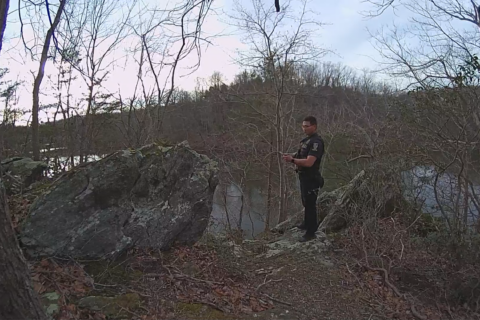
Body camera footage shows officers take down rabid coyote that attacked 2 in Montgomery Co.

Coyote tests positive for rabies after attacking 2 women in Montgomery Co.
Recommended.

Amber Alert issued across Virginia for missing Richmond 15-year-old

What to do if you find debris from the Baltimore Key Bridge collapse

WATCH: Video shows 'utter chaos and disorder' during Fairfax Co. 'street takeover,' police chief says
Related categories:.
School bus driver accused of assaulting student 'went too far,' Massachusetts superintendent says
Authorities have shed more light in the alleged assault of a student by a Massachusetts school bus driver in Ashby on Tuesday.
Video of the incident shows “the bus driver physically handle the student,” North Middlesex Regional School District Superintendent Brad Morgan said.
“Quite honestly, I was horrified by it,” he added.
No injuries were reported in the incident, which took place after Hawthorne Middle School in Townsend was out and the bus was dropping students off in nearby Ashby. Ashby police are seeking a summons for the driver, a 64-year-old Ashby man, Chief Derek Pepple said in a statement.
Dee Bus Service confirmed Wednesday that the driver, who hasn’t been publicly identified, no longer works for the company.
More from NBC Boston
- Mass. feeling impact of nor'easter as storm pounds region
- Pedestrian suffers life-threatening injuries after being hit by truck in Boston
The contractor previously said in a statement that it has “no tolerance for this alleged behavior” and was cooperating with the investigation.
Morgan said that “the bus driver went too far” in the incident, in which, according to the video, he pulled the bus over, asked the student to move and, when the student didn’t, put his hands on the student.
The student appeared to lose their balance in the aisle, and the driver maintained contact, according to Morgan. It ended up with the driver “on top of the student.”
The only reason for an adult to put their hands on a student would be for safety concerns, and “it did not look like the student’s safety was being threatened,” Morgan said.
He’s spoken with the father of the student, who “was extremely upset, and rightfully so.”
Amanda-Lee Gross said her two daughters, who were driven by the same man for years, would often tell her about the driver pulling over because of kids being rowdy. She said she believes parents should also hold their children accountable.
“I’m concerned for mainly the bus driver, because he literally has to stop and that’s really, really distracting, and if kids are doing things in the back of the bus that they are not supposed to be doing, that could cause an accident.”
But Morgan said that a student’s behavior is not an excuse for putting hands on them.
“If the way kids were behaving was creating such an issue, the bus should’ve turned around and come back to the school and let the building administration handle it,” he said.
Oscar Margain is a reporter at NBC Boston.
Asher Klein is a managing editor at NBC Boston.
News from the Columbia Climate School
A Virtual Reality Film That Makes the Climate Crisis Feel “Real”
Olivia Black
Adrienne Day
“During one kayaking [trip] around the glacier, ice fell onto my kayak. I tried to save this one piece of glacier ice in my freezer. I watered it every day, trying to make it grow. Turns out I wanted to make a story,” said artist and filmmaker Jiabao Li of time spent in Alaska. Inspired by that trip, Jiabao created Once a Glacier , a 15-minute virtual reality (VR) film about a girl and her relationship with a glacier.
A work of climate fiction, Once a Glacier explores a world similar to our own—one with ice sheets that are disappearing as a casualty of climate change. The film traces the journey of a girl as she watches the glaciers around her slowly vanish. We follow her story, as a young girl who discovers the glacier, to her aging into an elderly woman who still protects the decades-old piece of the glacier in her freezer.

Jiabao uses VR technologies to try and cultivate a close connection between the audience and the world she creates. Unlike regular cinema films, VR gives viewers a fully immersive experience that detaches them from their physical surroundings, embedding them in a new world.
“You think of human life within a hundred [years], and glacial time in millions of years,” Jiabao said in an interview with GlacierHub. “Because of that, we can’t [see] glaciers shrinking. Virtual reality compresses time, so within a girl’s lifetime you can see the comparable disappearance of the glacier.”
Researchers agree that VR can be a valuable tool in reaching new audiences. “VR can influence users’ conceptual understanding of scale in a way that looking at things on a computer monitor doesn’t,” said Isabel Cordero , a polar research assistant at the Polar Geophysics and Glaciology group at the Lamont-Doherty Earth Observatory at Columbia University. “It’s one thing to tell someone that the Ross Ice Shelf in Antarctica is roughly the same size as Texas; and it’s another thing to show them just how much ice that actually is.”
Cordero, a scientist, has used VR as part of the research group’s Visualizing Ice Sheets in Extended Reality project (VISER). Part of their work includes making virtual models of ice sheets that can help people physically contextualize real-world processes and explore complex polar data sets in an interactive way.

In Once a Glacier, viewers have an opportunity to interact with the main character. For instance, viewers can water the piece of glacial ice in the woman’s fridge. In the end, the audience can virtually follow along as the piece of ice she so fervently cared for is auctioned off into a museum, hailed as the last glacier in the world.
“It’s one thing to tell someone that the Ross Ice Shelf in Antarctica is roughly the same size as Texas; and it’s another thing to show them just how much ice that actually is.” – Isabel Cordero, Polar Geophysics and Glaciology group at the Lamont-Doherty Earth Observatory
Sound plays a critical role in the film. In Iñupiaq culture, glaciers carry memory through sound. The Iñupiaq are an Indigenous Peoples found across the Arctic who inspired Jiabao to create the grandmother character in the film, voiced by Carolyn Nahyoumaurak. While Western science focuses on observing the history of glaciers through ice cores (which can reveal past environmental and climate conditions), Jiabao focuses on the ambient sounds of the glaciers to center viewers in the present. In one part of the film, the audience kayaks with the main character through towering glaciers as cracking ice and breaking bubbles follow closely behind. To make the scenes as realistic as possible, her team recorded the sounds from real glaciers in Alaska. Voice acting is also important in the film; poetic narration reflecting the film’s main message.
“I am not alone,” the girl’s voice echoes as a poem is read in the film. “I am the keeper of frozen memory, brimming always, of time that should never end, of blue ice pure to its blue core. I am not alone.”
Science reveals the imminence of climate change, yet we still struggle to pass comprehensive policies and spur action. A new study argues the problem lies not in people’s perceptions of the urgency of climate change, but from a flaw in climate change messaging—we need to show people that “we are not alone.” Empathy is critical here, and VR films, by building close links between the audience and the characters, are one way to connect us with our fellow humans—and by extension our changing planet. Through VR technology, viewers can experience climate change in new ways that hopefully spur them to action.
Related Posts

This Earth Day, Choose the Planet Over Plastics

Key Ocean Current Contains a Warning on Climate

Summer 2024 Climate School Internship Opportunities

Get the Columbia Climate School Newsletter →

IMAGES
VIDEO
COMMENTS
What to Include in The Email to Your Teacher About Homework. Subject Line: Be specific and concise, e.g., "Question About [Assignment Name] Due [Date].". Greeting: Address your teacher formally, using "Mr./Ms./Mrs. [Last Name].". Introduction: Start by introducing yourself, especially if it's early in the school year.
10. Participation in a School Event. 11. Addressing a Missed Deadline. 12. Inquiry About Letter of Recommendation. 13: Request for Clarification on Assignment. 14 Expression of Interest in a Subject Area. Email 15: Request for Feedback on Draft.
2. Example email to a teacher about a late assignment. Dear [Teacher's Name], I apologize for submitting my assignment late. Unfortunately, unforeseen circumstances arose that prevented me from completing it on time. I understand the importance of timely submissions and take full responsibility for my actions.
Learning how to write an email to a teacher can be an intimidating task. Gain insight from our clear guide to writing an appropriate (and polite) email. ... Whether you've got a quick question, need to submit your homework, or have a concern about your child's class performance, writing an email to a teacher is an important skill. ...
Email to teacher about homework template. Thanks to Flowrite, you can forget canned responses, countless manual email templates, copy and pasting, and typing as you know it. Use Flowrite to to generate AI-powered messages with one click today. See it for yourself and test some of our templates below:
Using the teacher or professor's name shows respect and personalizes the email, creating a connection. Make sure you've spell-checked the name. Examples: Hello Mr. Johnson, Dear Professor Meyers, To Whom it May Concern, Step 3: Introduce the Issue. A brief introduction is like a warm-up.
Ensure you have a good reason for emailing. Use their school email account. Choose the right time to email a teacher. Craft a detailed subject line. Greet a teacher respectively. Be concise and clear. Format your email for better readability. Be polite and show gratitude. Label any attached files properly.
1. Repeat after me: an email is not a text message!!! 2. Repeat after me: an email is not a novel or an epic poem. 3. Always enter in a subject line. Never leave this field blank. Keep it short and to the point, basically like giving your email a "title.".
8. End the email. There are many ways to end most emails, but you should always end emails to teachers with some variation of "Thank you," on its own line and then your name on a separate line. Possible substitutions for "Thank you" include "Sincerely", "Regards", and "Best".
Step 1: Determine the Purpose of Your Email. Step 2: Choose a Clear and Concise Subject Line. How to write an email to a teacher | Examples of subject lines. Step 3: Use a Professional Greeting. Step 4: Introduce Yourself. Step 5: Clearly State the Purpose of Your Email. How to write an email to a teacher | Examples of stating your request.
For example, you can greet a teacher with a "Hello" or a "Good afternoon.". Remember to add their title and last name. Avoid writing the email the same way you would text your friends, as it's not appropriate, even if you're friendly with your teacher during the class. There's no need to use abbreviations, and make sure to use ...
Sometimes you may need to add an attachment to your email, like if your child is out sick and you need to submit their makeup classwork. Make sure your email mentions any attachments, and name each attachment appropriately. Also, remember that most email servers allow a maximum of 25 MB per attachment. Sending a link to a cloud drive is a great ...
English teachers like that. Show some concern for the person reading the email: I hope you are having a good day. Remind your teacher how he knows you: I'm in your Monday 8-11 class. Say why you are writing your email: I am writing this email to tell you about a problem I am having and to ask you for your help.
An email to a teacher should have a clear purpose. It should be written in a polite and professional tone. Be sure to open with a proper greeting and sign off with your name. Here are 14 tips for writing a good email to a teacher.
Start by using the correct title and surname. If you are unsure about how to address your teacher, it's best to use a formal title such as "Professor," "Doctor," or "Mr./Ms./Mrs." followed by their last name. For example, "Dear Professor Johnson" or "Hello Dr. Smith.".
Hi [Name], Good morning [Name], Good evening [Name], Use formal closing lines. Always include a send-off, especially in your first email. "Sincerely" is always a good option. "All the best" and "best regards" are also formal, appropriate options. Always include greetings and closings to make a respectful and courteous impression.
1. How to write an excuse email to professor example. Dear Professor (name), My name is (your name), and I'm in your (insert details) class. First, I would like to apologize personally and explain why I have been unable to (insert what you need an excuse for). II would like to reassure you that this won't happen again.
2. Open with a professional greeting. Address the teacher or professor politely by their title and last name on the first line of your email. Avoid using the instructor's first name (unless you're on a first-name basis) and stick with a formal greeting like "Dear" or "Good morning.". [2] "Good morning, Mr. Dickson,".
Email Etiquette: Teaching Students How to Email a Teacher. Email etiquette can be one of the most beneficial writing lessons of the school year. Students make great gains in a short amount of time. Consider…. From: [email protected]. To: [email protected].
Then, make sure to be as courteous as possible throughout your email as well. [3] Use a formal greeting. "Dear Professor James," and "Professor James," are perfect. "Hey," and "Hi," are too informal and should be avoided. Same goes for your signoff—choose a formal phrase. "Best," and "Sincerely," are great picks.
Email Template #4: The Gentle Nudge. A good friend has a job where she has to constantly remind people that they haven't paid their bill on time or haven't sent the documents they promised. She swears that you can get away with asking for anything if you begin your request with, "just a friendly reminder.".
I stepped off the "wheel" and looked at her ever growing, sweet face. I listened to her tell stories about her friends, teacher, and the next social dilemma she was pondering. Fifteen wonderful minutes without chores, homework, or email. We laughed and shared stories.
A $1.6 million donation from the William A. Brookshire Foundation to Texas Tech University will found the Texas Tech School of Law Veterans Clinic - a service free to veterans that provides for their legal needs. The gift will also offer a first-of-its-kind scholarship at Texas Tech for working students in the Edward E. Whitacre Jr. College of Engineering.
1 |I am writing this email to inform you that I forgot to submit my assignment. It was due today, but I didn't have time to finish it in time. I apologize and I hope you understand. 2| I am very sorry to report that I have not completed my homework yet. I did not have time after school today and would like to do it now.
March 29, 2024, 6:52 AM PDT. By Katherine Itoh. Two 10-year-old students were arrested in connection with a gun sold at their elementary school in Florida, county officials confirmed. A deputy's ...
First lady Jill Biden speaks during a media preview Oct. 24, 2023, in the State Dining Room at the White House in Washington, ahead of Wednesday's State Dinner with Australia's Prime Minister ...
Gen Zers might be reshaping the world of work — but only if they have a job.And, for many, that might not be the case. New research from the St. Louis Federal Reserve's Institute for Economic ...
A 12-year-old boy has suffered serious injuries after being hit by a car on his way to school Thursday morning in Damascus, MD. Montgomery County police told WTOP they were called to the area of ...
Morgan said that "the bus driver went too far" in the incident, in which, according to the video, he pulled the bus over, asked the student to move and, when the student didn't, put his ...
A work of climate fiction, Once a Glacier explores a world similar to our own—one with ice sheets that are disappearing as a casualty of climate change. The film traces the journey of a girl as she watches the glaciers around her slowly vanish. We follow her story, as a young girl who discovers the glacier, to her aging into an elderly woman ...